Here are a pair of acquisitions from Melody Strachan, formerly of Susanville, California. Some of you might have seen a listing her sister placed on Facebook Marketplace back in November, selling the camera collection of Melody’s late husband. We reached out to Melody at the time and, since then, kept in contact, working with her to purchase a Type A-2 Vertical View Finder and a Type K-3 Gunsight.
The Type K-3 Gunsight was used by the Type A-1 Upper Turret on the Boeing B-17. Both the gunsight and the turret were designed by Sperry Gyroscope of Brooklyn, New York. A rather sophisticated analog computer, the K-3 used data imported by the gunner to calculate target lead and range. Since aerial gunners were trained to memorize the wingspan of enemy aircraft, this data was entered into the computer. The sight reticule was then adjusted via the turret’s hand control, framing the target to calculate range.
This particular K-3 was manufactured by the National Cash Register Co. of Dayton, Ohio. Established in 1879, said company was founded by cash register inventor, James Ritty, and greatly expanded under the ownership of industrialist John Henry Patterson. A difficult man, Patterson was infamous for firing employees on minor pretenses, his wrath incurring such future luminaries as Charles Kettering and Thomas Watson. While no longer located in Dayton (they are now in Atlanta, Georgia), NCR remains in business to this day, manufacturing self-checkout kiosks.
This K-3 is our first purchase using the funds amassed from the April turret parts fundraiser. While K-3s do occasionally appear on the collectors’ market, for accuracy’s sake, we purposely waited in the hopes of finding an early variant sight for Lucky Thirteen. Now we have achieved that goal. Thanks to everyone who contributed back in April – we hope you approve!
The Fairchild A-2 Vertical View Finder is a bit more obscure in its usage.
The B-17 carried its strike camera in a pit located under the floor of the radio compartment. Opening the floor into pit revealed a pair of doors – one for the camera and one for the view finder. While it was not uncommon for bomber crews to blindly snap photos during the bomb run, the A-2 was nevertheless intended for the radio operator to actually aim the adjacently mounted camera.
In all but one of her seven combat missions, Lucky Thirteen carried a strike camera: three times a Kodak K-24, twice a Fairchild K-17, and once a Graflex K-21. Since she carried a K-17 on her final mission, this is the setup we are pursuing.
Like the giant K-17, the A-2 Vertical View Finder was manufactured by Fairchild Aviation of Farmingdale, New York. Founder Sherman Fairchild cornered a niche market in the Interwar years by expanding into aerial surveying and designing specialized aerial photography equipment. Best known today for the A-10 Thunderbolt II, Fairchild, along with previous acquisitions Republic and Dornier, was purchased by M7 Aerospace of San Antonio, Texas in 2003.
The A-2 Vertical View Finder is one of the last major components needed for Lucky Thirteen‘s camera pit. All that remains is the mount for the K-17, which in wartime was either the Bruening-Winans Type A-8 or Robinson Type A-11. So far, the only one we have located is currently in Thailand, which would cost nearly 400 USD in shipping alone if we were to pursue it. If someone closer has an example they are willing to part with, or perhaps someone wishes to help acquire the example overseas, please let us know!
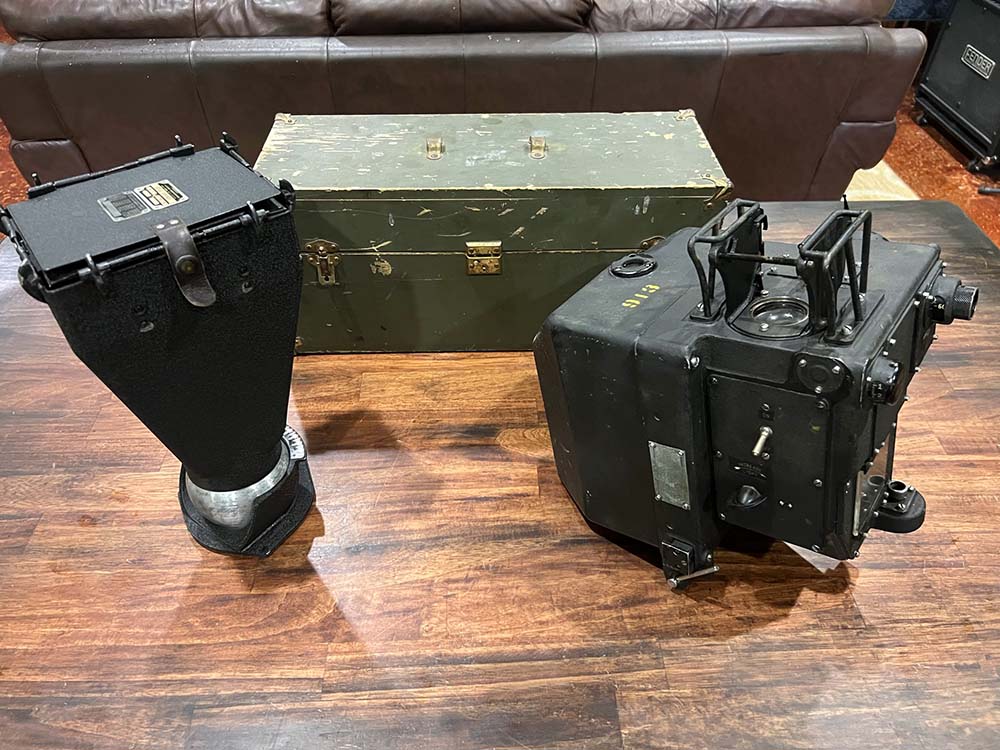
The newly arrived Type A-2 Vertical View Finder and Type K-3 Gunsight.
Photo taken 11 September 2022.
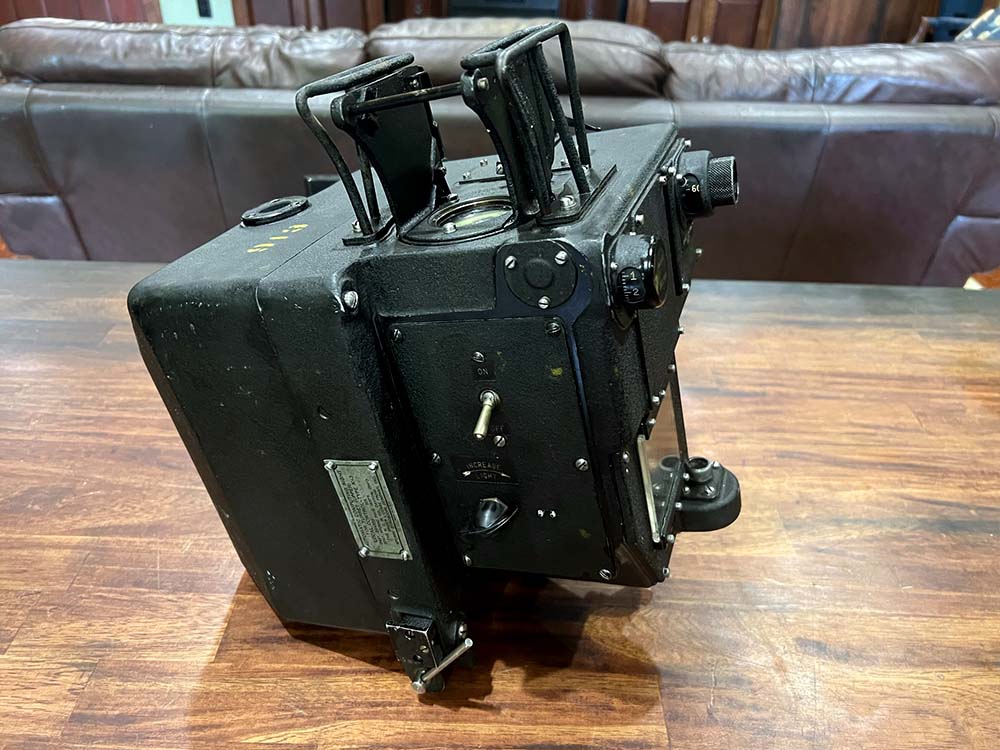
The newly arrived Type K-3 Gunsight.
Older variants, like this one, can be differentiated from later models by their switch plates. Later gunsights had recessed switches and a knob assembly to make adjusting target wingspan easier.
The switch here is a simple On/Off switch. The knob adjusts the brightness of the sight reticule.
Photo taken 11 September 2022.

Manual illustration of a Type K-3 Gunsight. As you can see, the variant illustrated here matches the sight we acquired.
The tuning cables attached to the sight function much the same an automotive speedometer cable. These three cables input data on the target’s range, as well as the turret’s current elevation and azimuth.
The knob on the top right is for manually inputting target wingspan.
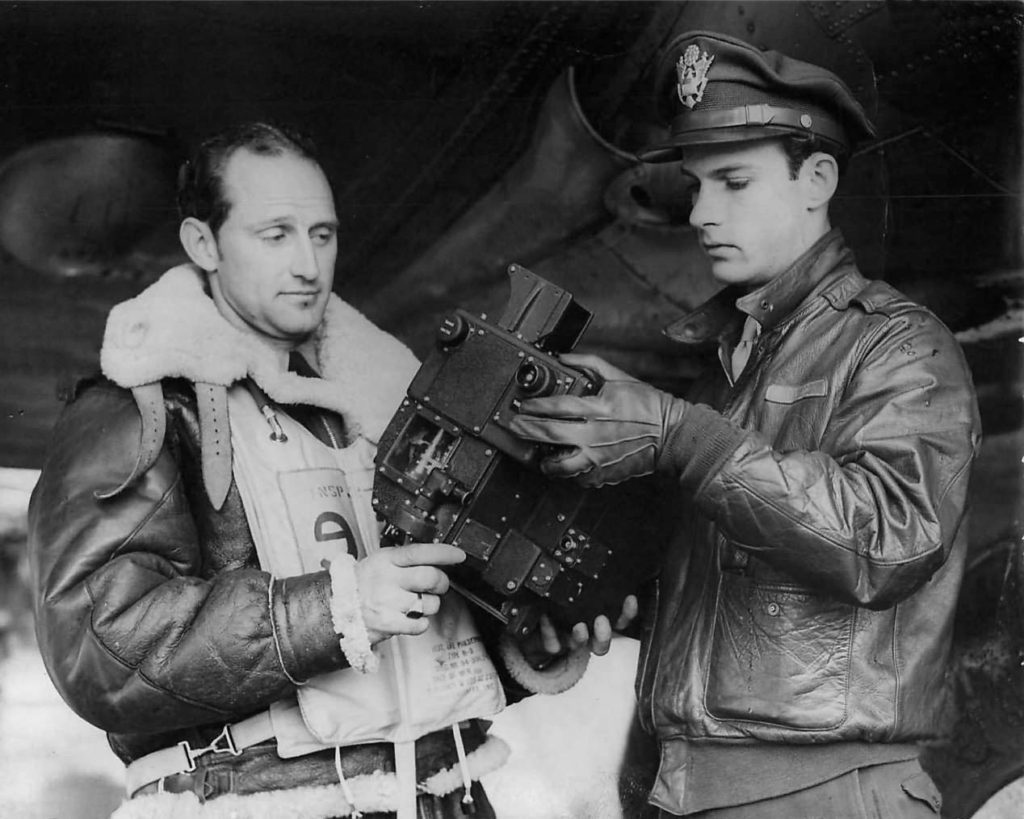
Airman of the 306BG pose with an early-variant Type K-3 Gunsight.
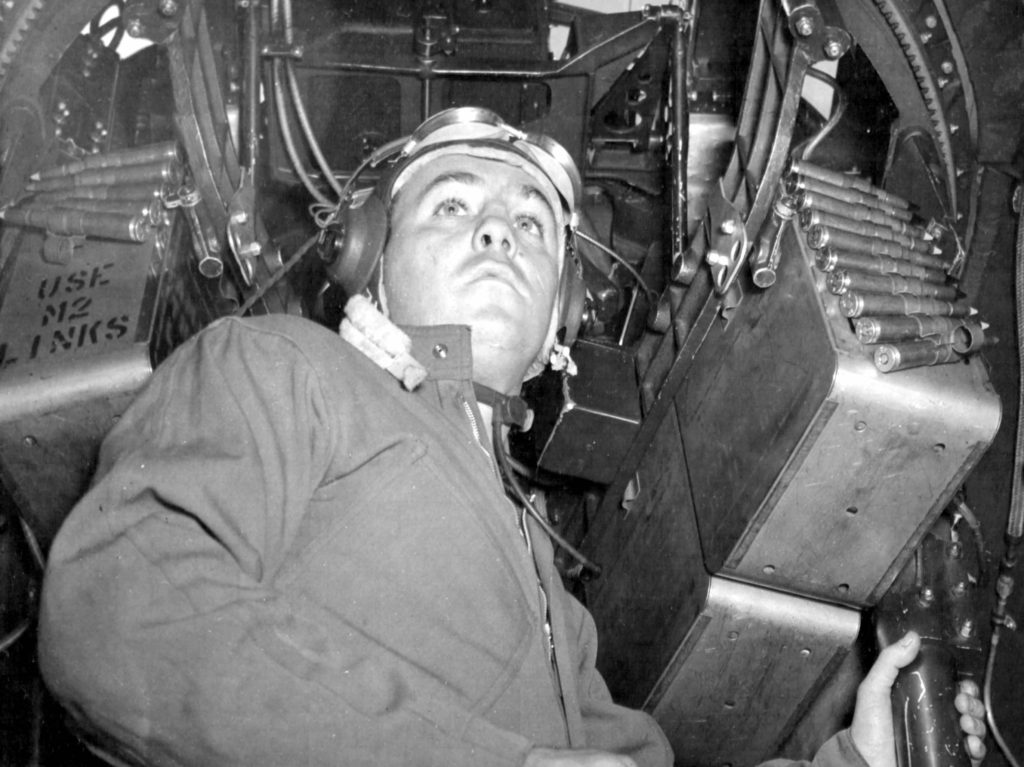
An airman poses with the Type A-1 Upper Turret aboard Hell’s Angels (41-24577, 303BG). The Type K-3 Gunsight can be seen above.
The stainless steel ammunition cans on either side held 133 rounds each. Later models were galvanized. The Types A-1 and A-1A Upper Turrets carried six ammo cans each. The late-war A-1B carried a pair of 700 magazines for its guns.
If you can help with the early-style ammo cans for Lucky Thirteen, please let us know!
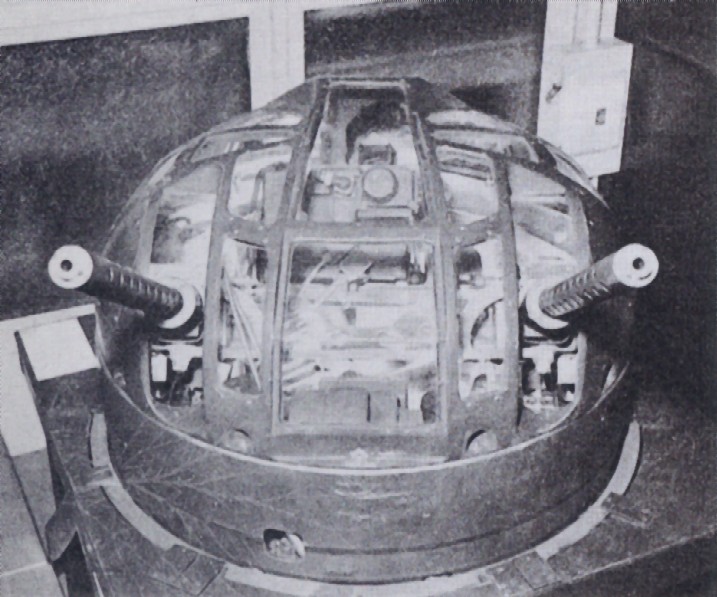
The business end of a Type A-1 Upper Turret.
Type A-1 turrets were manufactured by Steel Products & Engineering (SPECO) of Springfield, Ohio and Emerson Electric of St. Louis, Missouri. While SPECO continuously upgraded aspects of the turret’s design, Emerson largely locked the design to ease mass production.
Early domes, like this one, were still used by Emerson-built turrets long after SPECO had introduced roomier domes. Note the hump at the back of the dome, intended to give the gunner enough headroom to use the gunsight.
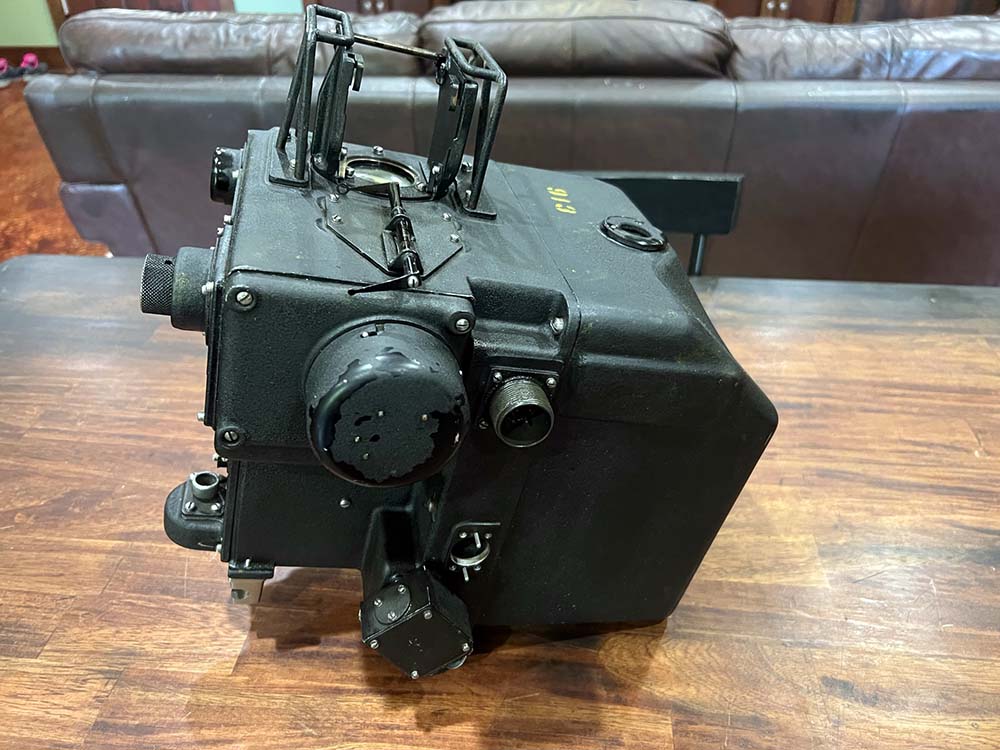
Front view of the newly arrived Type K-3 Gunsight.
The large cylindrical piece is the lamp case. The plug beside it the power receptacle. The square piece at the bottom is the tuning cable receptacle for the azimuth drive. The receptacle for the elevation drive is missing.
Photo taken 11 September 2022.
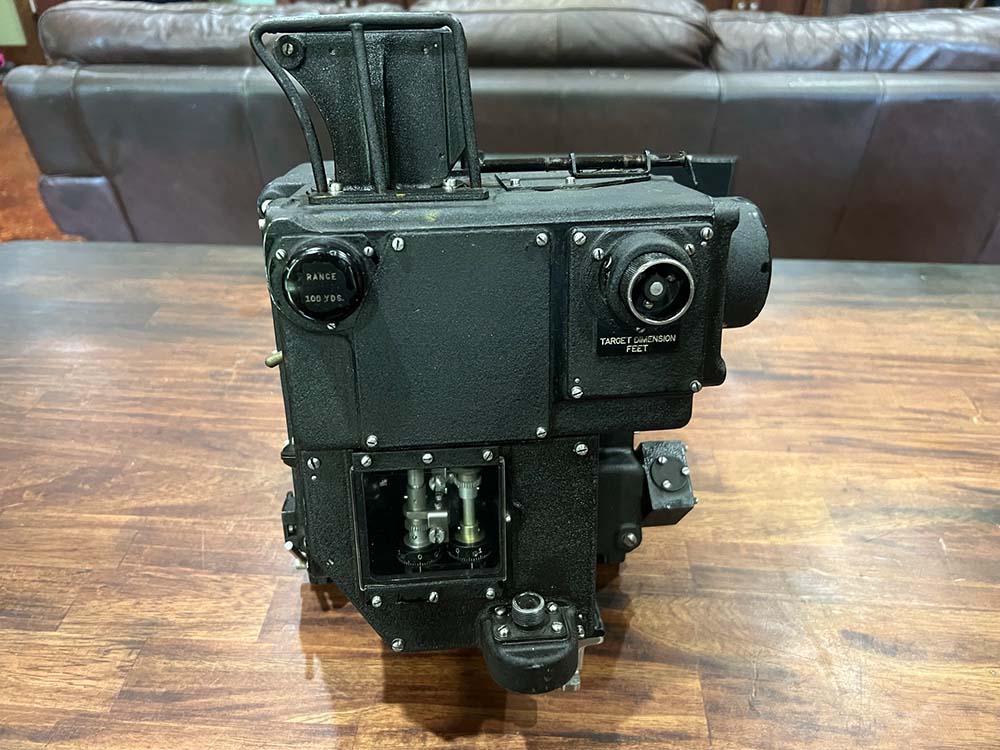
Side view of the newly arrived Type K-3 Gunsight.
The indicator for the target’s range is on the left. The manual input for the target’s wingspan is on the right. The receptacle for adjusting the range reticle is on the bottom.
Photo taken 11 September 2022.
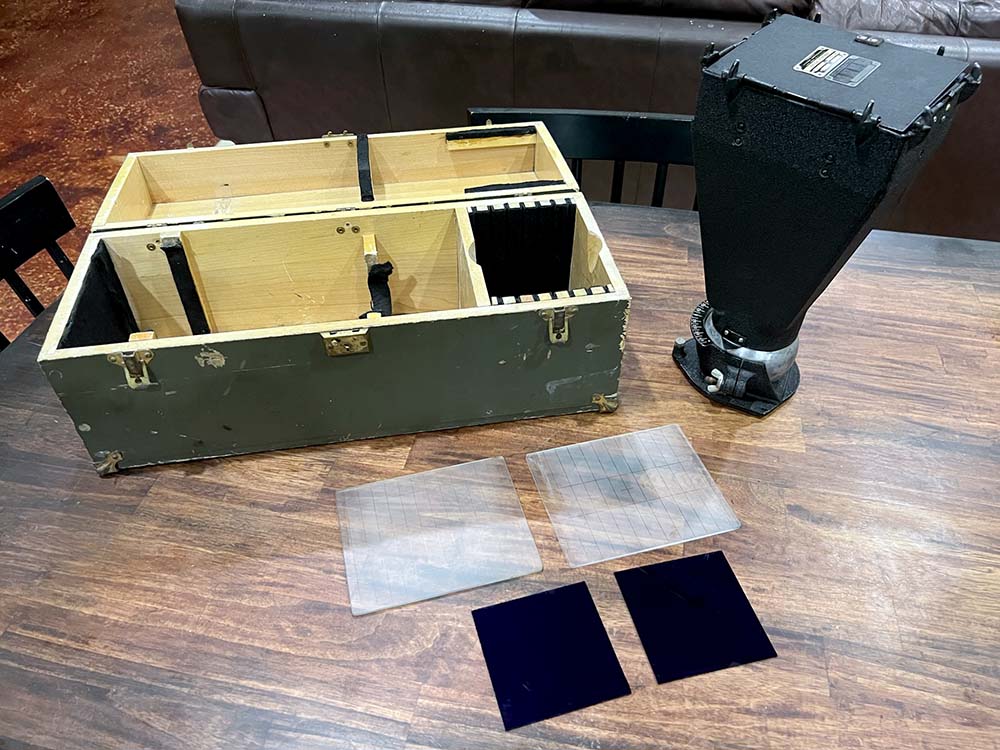
The newly arrived Type A-2 Vertical View Finder, complete with its storage case.
Photo taken 11 September 2022.

The newly arrived Type A-2 Vertical View Finder.
The scope is covered with four spring-loaded panels, held in place with a leather strap. A series of glass grids, used for measuring, can be swapped out as needed. The swivel holding the lens is mounted to the aircraft floor.
Photo taken 11 September 2022.
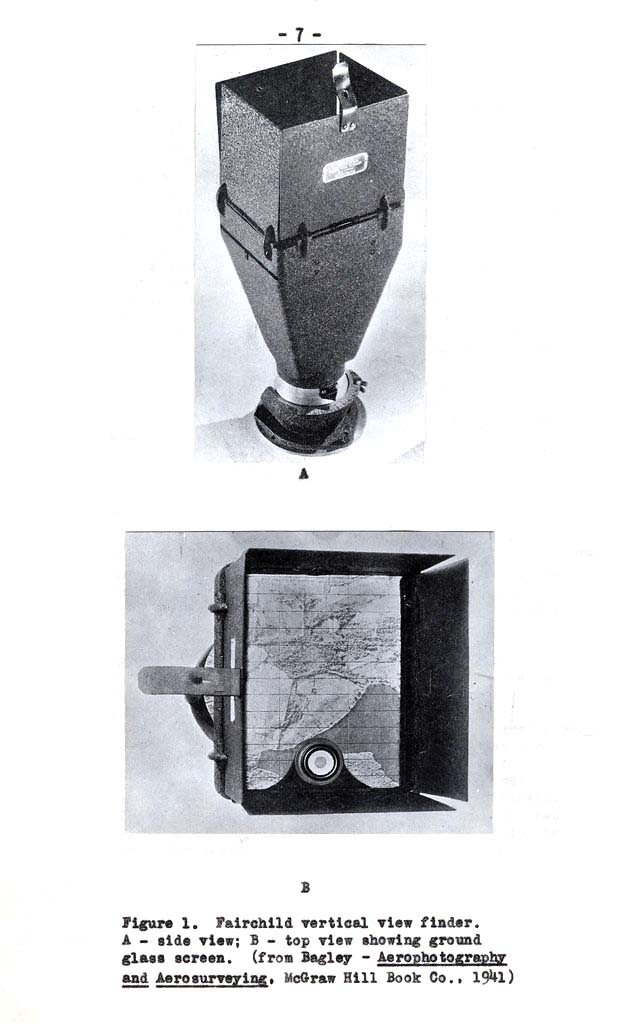
Manual illustration of a Type A-2 Vertical View Finder.
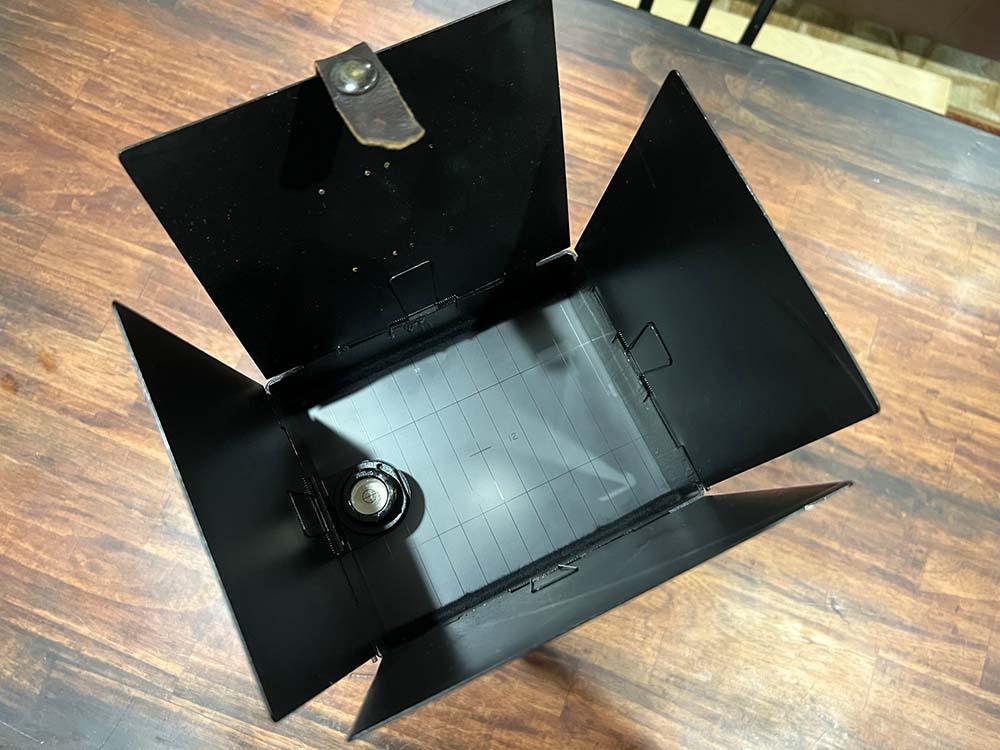
Looking inside the Type A-2 Vertical View Finder.
Photo taken 11 September 2022.
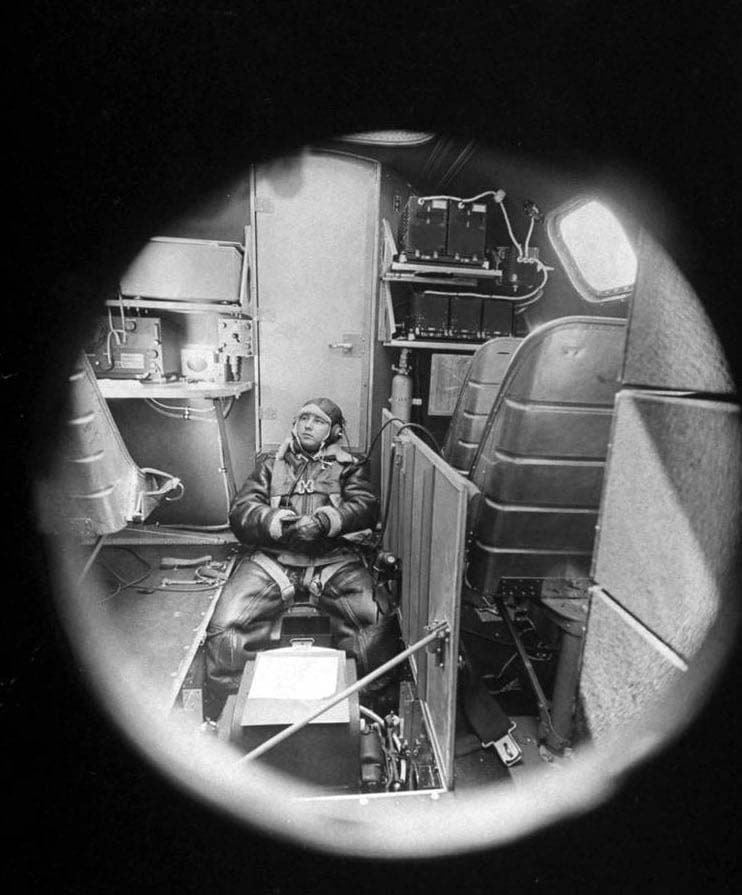
A heavily censored Life magazine photo showing the B-17’s camera pit in use. The Type A-2 Vertical View Finder is visible between the airman’s legs.
The B-17 pictured is likely an E or early F model. While the aircraft’s radio compartment carried enough oxygen hookups to accommodate two extra passengers, the additional seats shown here were quickly removed.
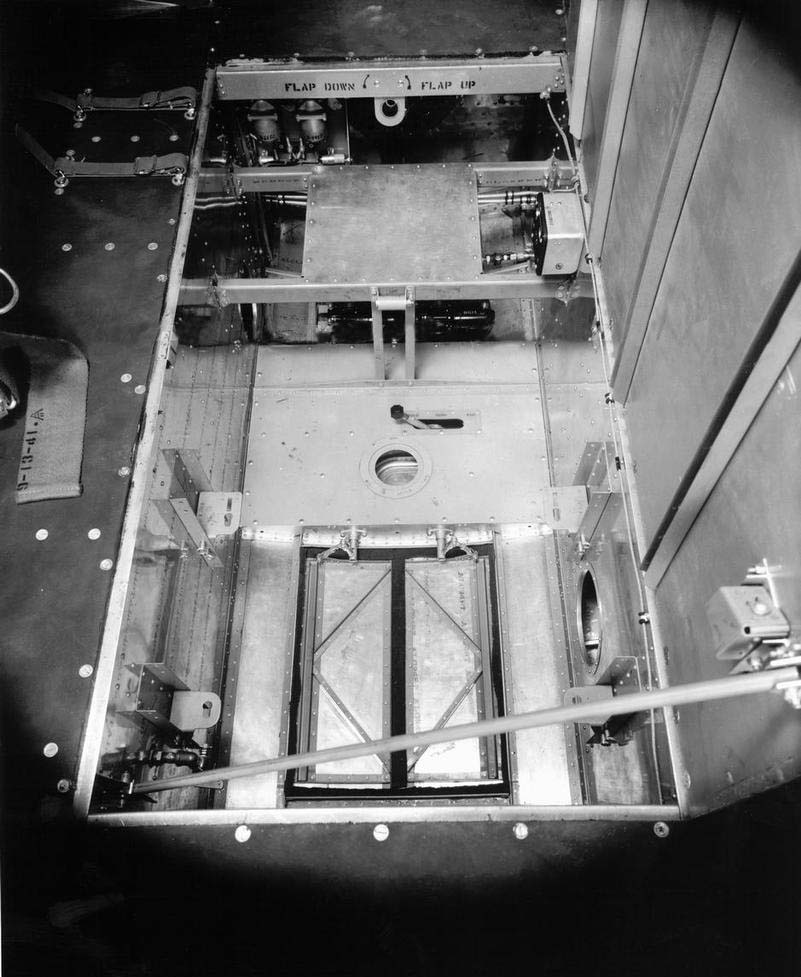
Factory photo of the camera pit aboard an E-model B-17.
Note the doors inside. The larger door is for the strike camera. The channels on either side are for the camera’s mount. The smaller round hole is for the vertical view finder.
Photo taken 16 September 1941.
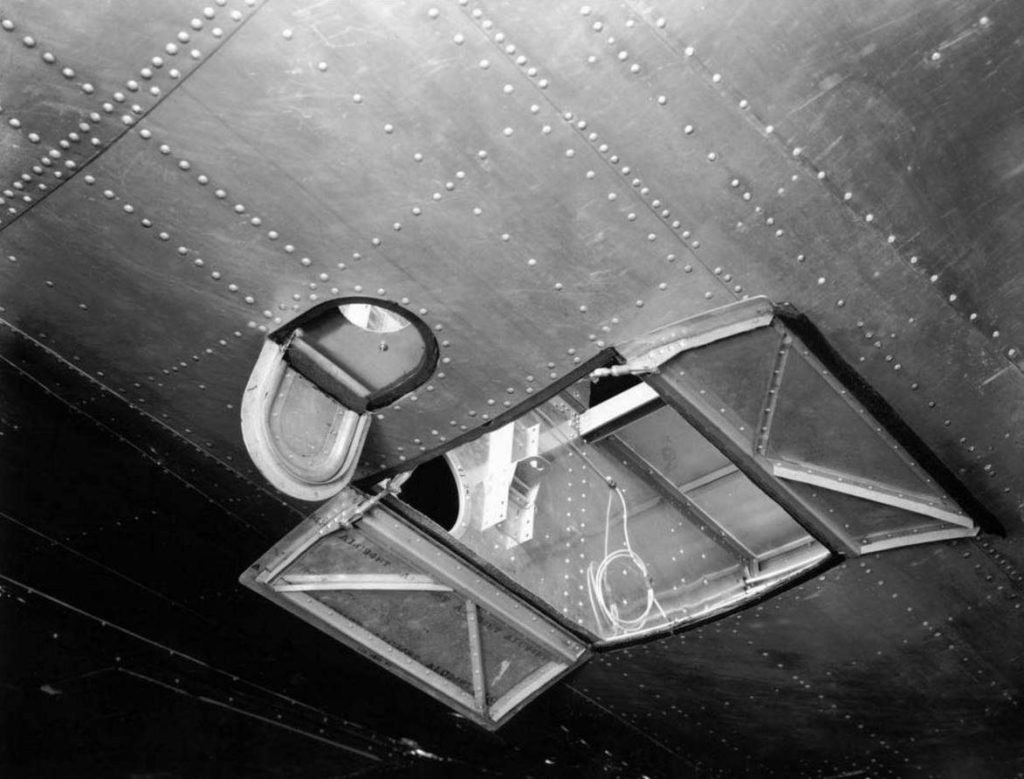
This photo shows the doorways underneath the radio operator’s compartment on a B-17.
The right doorway holds the bomber’s strike camera. An original, gigantic Type K-17 Camera was donated to Hangar Thirteen by SSgt Max Pearsall, USAF in October 2021.
The left doorway holds the bomber’s Vertical View Finder.
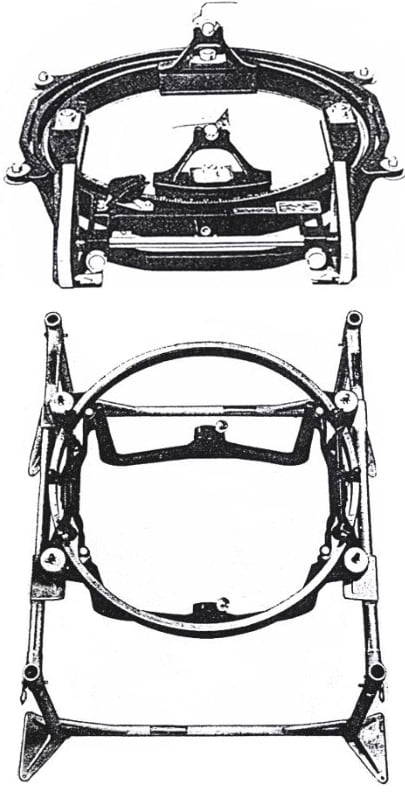
The Type K-17 camera was designed to be held by either the Robinson Type A-11 mount (above) or Bruening-Winan Type A-8 mount (below).
If you can help with this need, please let us know! The camera mount is the last major component needed to outfit the camera pit for Lucky Thirteen.
Station 5 was the back wall of the bomb bay, as well as the forward wall of the radio compartment. Naturally, a large amount of equipment was mounted here. We must be careful about the radio room side, as this compartment was insulated and upholstered on F-model B-17s. As such, every piece mounted here will require spacers of various sizes and types.
This fact, combined with our recent oxygen panel work, suggested we begin by mounting the bomb bay oxygen equipment.
To the right of the Station 5 door, facing aft, was a Type A-4 Walkaround Oxygen Bottle and an oxygen panel with a 6 ft hose. This oxygen panel is somewhat unique as it was removed from the B-17 toward the end of the F-series.
The recently arrived bomb hoist rack was stowed to the left of the door and is currently undergoing restoration. The recently restored Type D-16 Fuel Transfer Handpump will require a special bracket be fabricated before it can be mounted. If anyone out there would be interested in making this piece, do let us know, as we can never have too many fabrication volunteers!
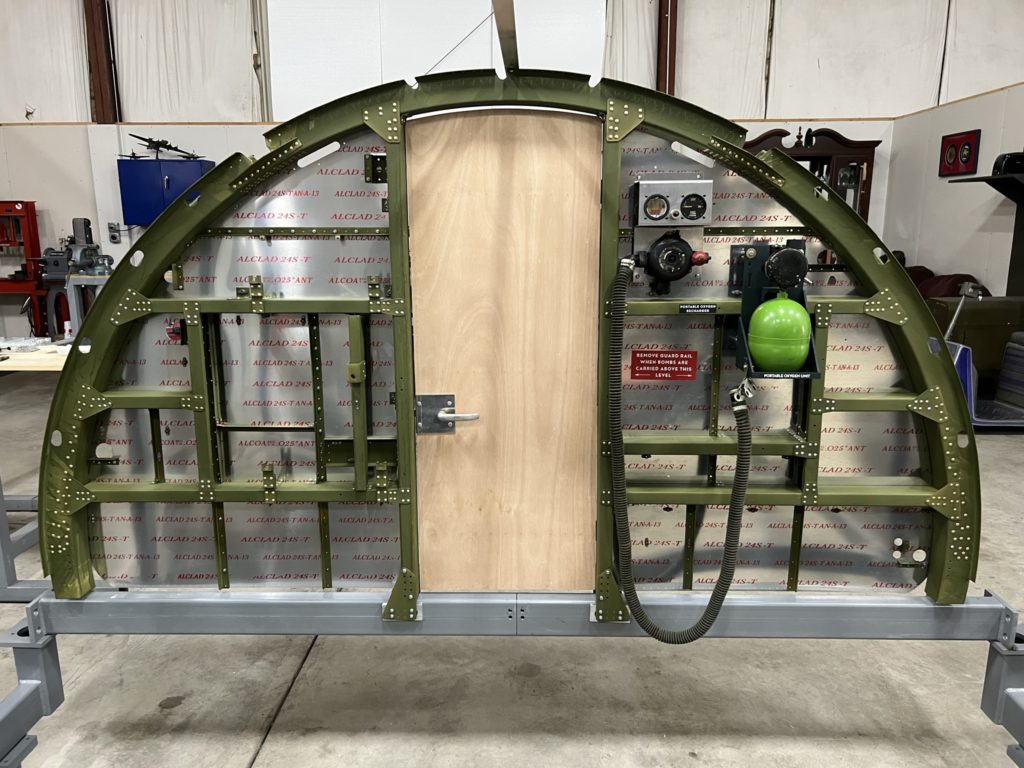
The newly finished oxygen equipment mounted to Station 5 of Lucky Thirteen.
Note the 6 ft oxygen hose. While we have plenty of 4 ft hoses, in reality, the B-17 was supposed to carry 6 ft hoses for 11 of its 13 oxygen positions.
The gauges in the oxygen panel were donated by Steve Hester and Joe McKowen. The Type A-4 walkaround bottle was donated by Chris Wilkinson. We still need at least four more Type A-1 Oxygen Flow Gauges, one more Type K-1 Oxygen Pressure Gauges, eight more Pioneer Type A-12 Regulators, and 11 more A-4 walkaround bottles to fill out the bomber’s needs.
Photo taken 1 September 2022.
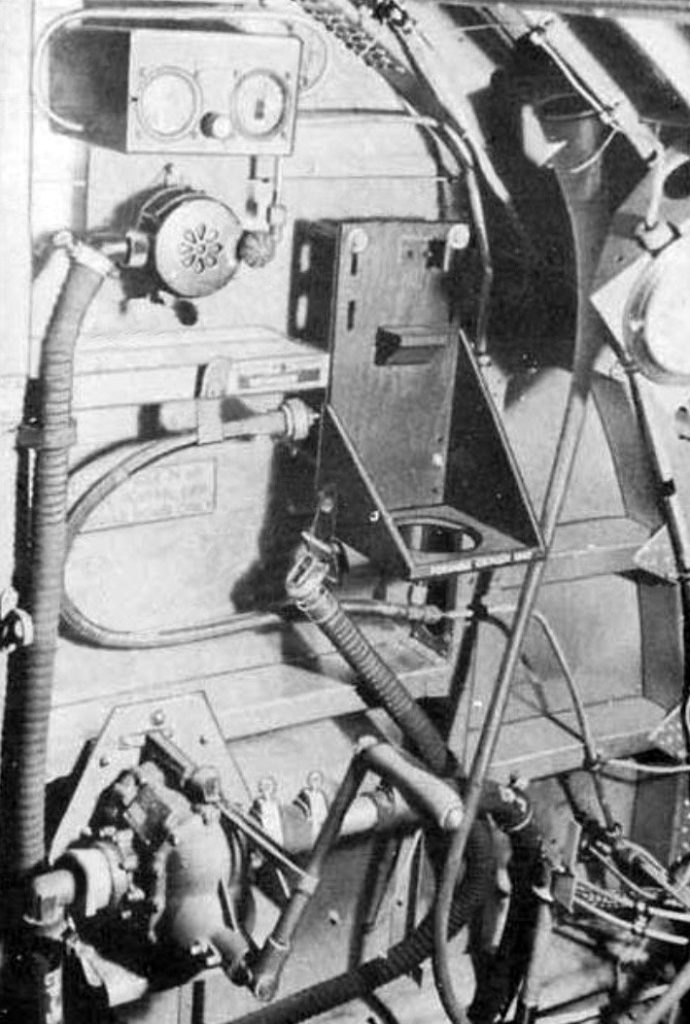
A manual illustration of the Station 5 oxygen equipment aboard a B-17F.
The oxygen panel here is equipped with an Aro Type A-12 Regulator, while we have elected to use types made by Bendix Pioneer. Both were common in wartime. We need at least eight more to completely outfit the bomber.
Curiously, the fittings which attach the hose to the regulator are sized differently between brands, and only one of our regulators still has its hose attachment fitting. If you can help with this, please let us know!
Note the Type D-16 Fuel Transfer Handpump and the Walkaround Bottle Recharge Line. Both of these still need to be mounted.
To the right, on the wall, are one of the overhead lights for the bay, as well as the urine ‘relief’ tube.
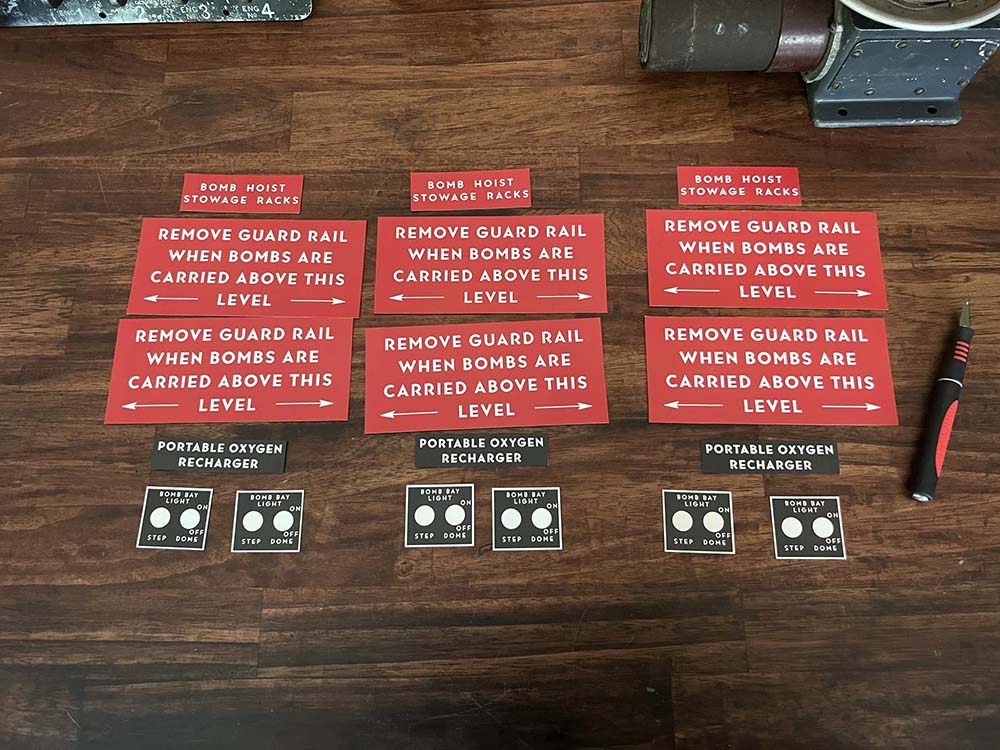
Decals for Station 5 of Lucky Thirteen.
Spares are made in case of mistakes.
Photo taken 13 June 2022.
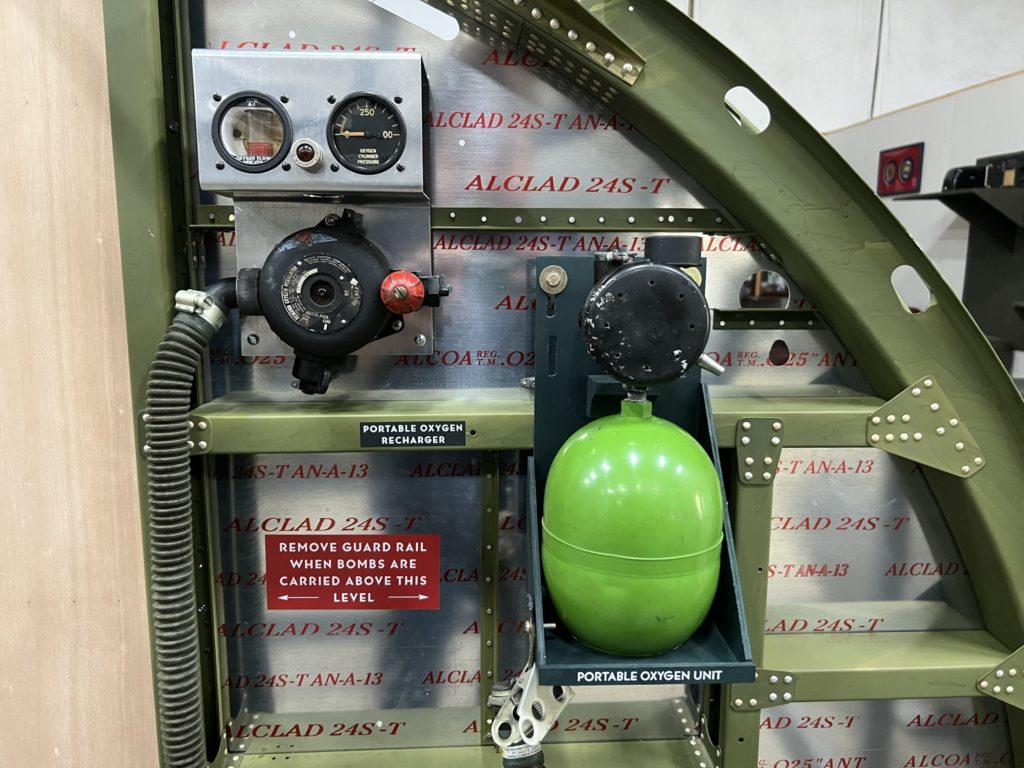
Each of the three factories which produced B-17s during the war (Boeing-Seattle, Douglas-Long Beach, and Vega-Burbank) had unique ways of interpreting finish specifications. One of these was the bomb bay as, on camouflaged Boeing aircraft, the bay was usually painted the same gray as the exterior. On Douglas aircraft, the bay was left unpainted.
This resulted in some interesting decal issues. The red placard here, for example, was gray with red letters on Boeing aircraft. Thankfully, we have photos and wreckage to confirm Douglas’s interpretation of this particular decal.
Photo taken 1 September 2022.

An unidentified airman squeezes through the bomb bay of a B-17, carrying a Type A-4 walkaround oxygen bottle. This photo was taken from Station 5, looking forward toward Station 4 (the back wall of the cockpit).
The first of the demand-flow walkaround bottles, the A-4 gave the airman between 3 to 8 minutes of breathable oxygen.
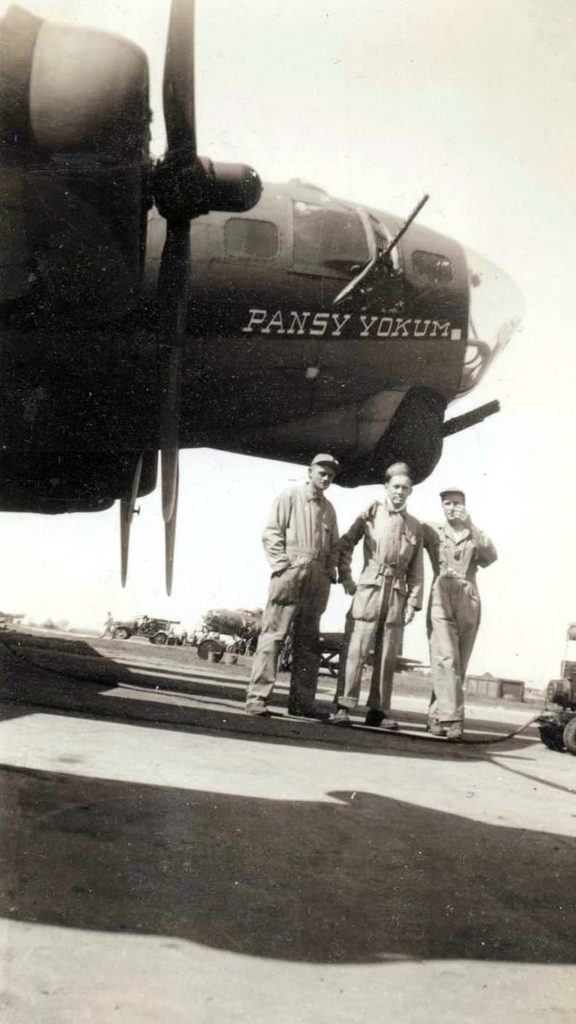
The bomb bay oxygen panel was intended for airmen using the fuel transfer handpump, so once the handpumps were removed, so too was the panel. However, said panel often proved invaluable as the tight spaces of the compartment made any work therein difficult.
A horrific example occurred on 8 March 1944 aboard Pansy Yokum (42-38141, 379BG).
Waist gunner SSGT Ervin Richey became stuck between the bomb racks while attempting to free a hung bomb. Since this B-17 was a G-model, the bomber lacked a bomb bay oxygen panel. The crew was faced with a dilemma: feed Richey a constant array of recharged walkaround bottles and use up the aircraft’s oxygen supply, drop from formation and be singled out by German interceptors, or leave Richey be.
They chose the latter and returned to base with a dead man stuck between the airplane’s bomb racks.
In truth they probably didn’t have much time to remedy the situation as the an A-4 bottle only provides a few minutes of oxygen. I would conjecture that he was gone before they really had a chance to save him.
Recently, our friend Chris Monroe with the B-17E Desert Rat, alerted us to a Fairchild Type B-2 Intervalometer that had become available. This type was more accurate to 1943 than the Type B-3B which we had previously obtained. As such, we quickly acquired this piece. Thanks for the heads up, Chris!
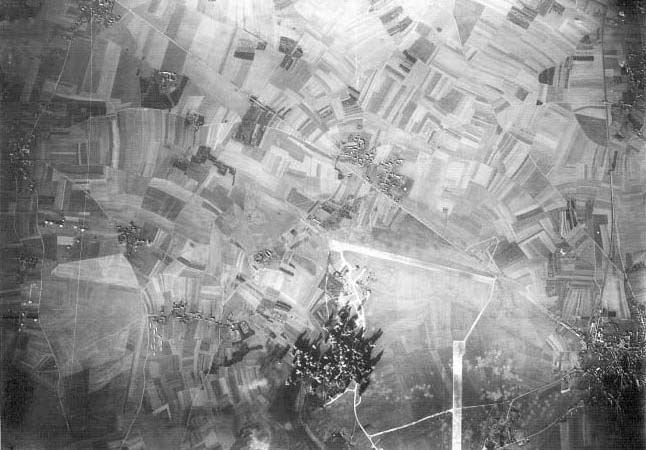
A strike photo taken of the airfield at Saint-André-de-l’Eure. While this photo is undated, the bomb pattern matches the aiming point described in the after-action reports for 3 September 1943 – targeting the barracks and workshop areas at a 322° heading.
The B-17’s strike camera was located under the floor of the radio compartment. Lucky Thirteen was one of the bombers carrying a strike camera this day, mounting a Kodak K-24. It is indeed possible that she took this photo.

The newly arrived Type B-2 Intervalometer.
Photo taken 2 September 2022.
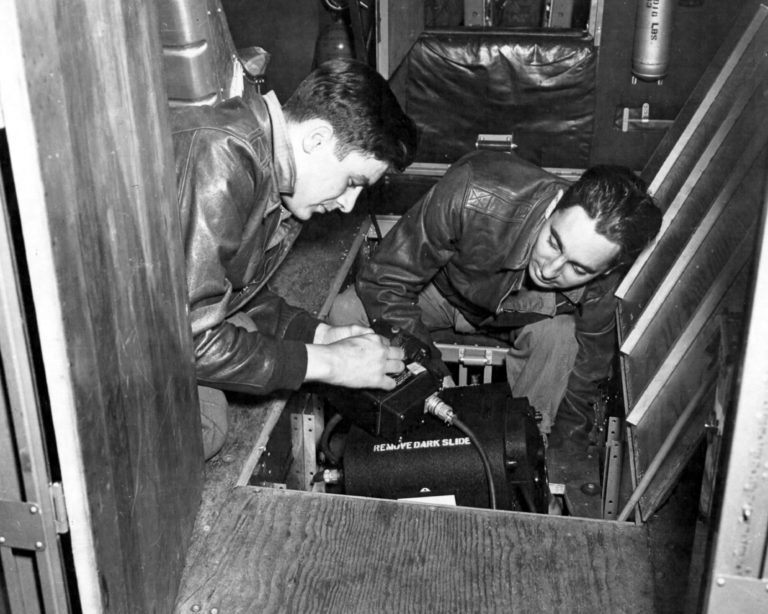
SSGTs Bill M. Lyon and John A. Feairheller install a strike camera aboard Our Gang (42-5069, 91BG).
Our Gang was lost over Schweinfurt on 17 August 1943.

The Type K-17 strike camera donated by SSgt Max Pearsall, USAF sitting on my dining table.
Lucky Thirteen carried a Type K-17 when she was shot down on 6 September 1943.
The baseball is for size comparison.
Photo taken 18 October 2021.
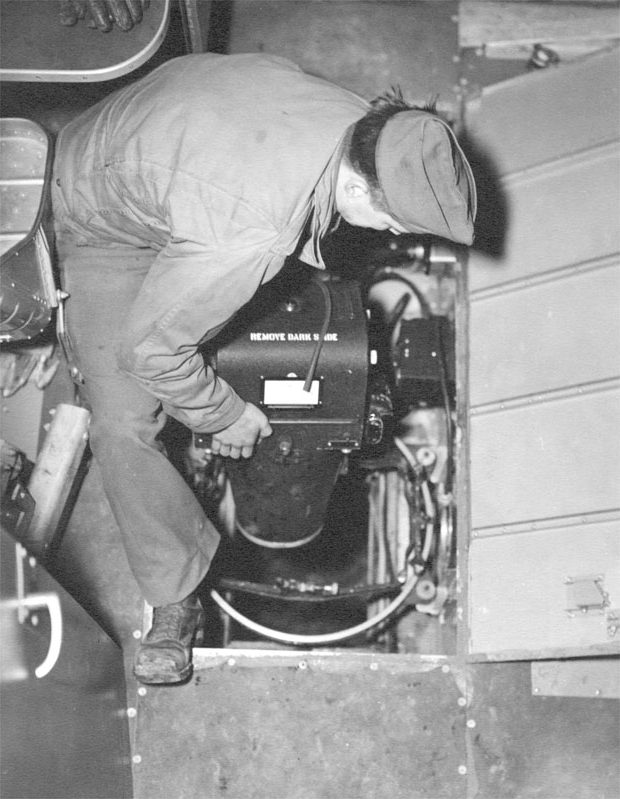
An airman of the 13th Photo Reconnaissance Squadron installs a Type K-17 Strike Camera aboard a Boeing B-17F.
Note the Type B-2 Intervalometer mounted on the camera bay’s side wall.
This handpump was recently acquired at the Wilson Shealy Estate Auction in Leesville, South Carolina. We were lucky to find it! It was part of a pile of ‘wobble pumps’ and looked vaguely familiar to me, sitting out there in the rain. I texted Karl Hauffe who diligently looked it up and confirmed its identity. By that time, it had already been sold. Thankfully, our friend Eric Miller, of Project Warbird, was able to convince the winning bidder (the awesome team at Round Engine Aero) to sell. Thanks guys!
The B-17 carried an emergency fuel pump on the bomb bay side of Station 5. Station 5 was the rear bulkhead of the bomb bay and is the one from Lucky Thirteen which is currently being riveted – so the timing was perfect! Older B-17s carried the Type D-15 pump, with the D-16 entering service in February 1943. Variants were made by Smith Meter of Los Angeles, California and Tokheim of Cedar Rapids, Iowa. Both companies are still operational.
It seems likely that Wilson Shealy used the pump to transfer fuel around the various Stearmans and drums on his property. We do not know how long it had sat outdoors as, while the pump was still functional, the exterior surface was quite nasty. As such, I took it home and cleaned it at my shop. With the exception of the forward faceplate and two flanges, the entire assembly is made of casted brass. The brass is heavily wrinkled, the result of the original molds being extensively used. All the original wrinkles and dings were left untouched as indicators of its true heritage. The only pieces to be replaced were the dataplate (which was badly corroded) and fiber gaskets.
The fuel transfer hand pump was later removed from the B-17 completely, though Boeing’s reasoning remains unclear. As such, this is a rare and unique piece which we hope you will enjoy seeing installed aboard Lucky Thirteen.
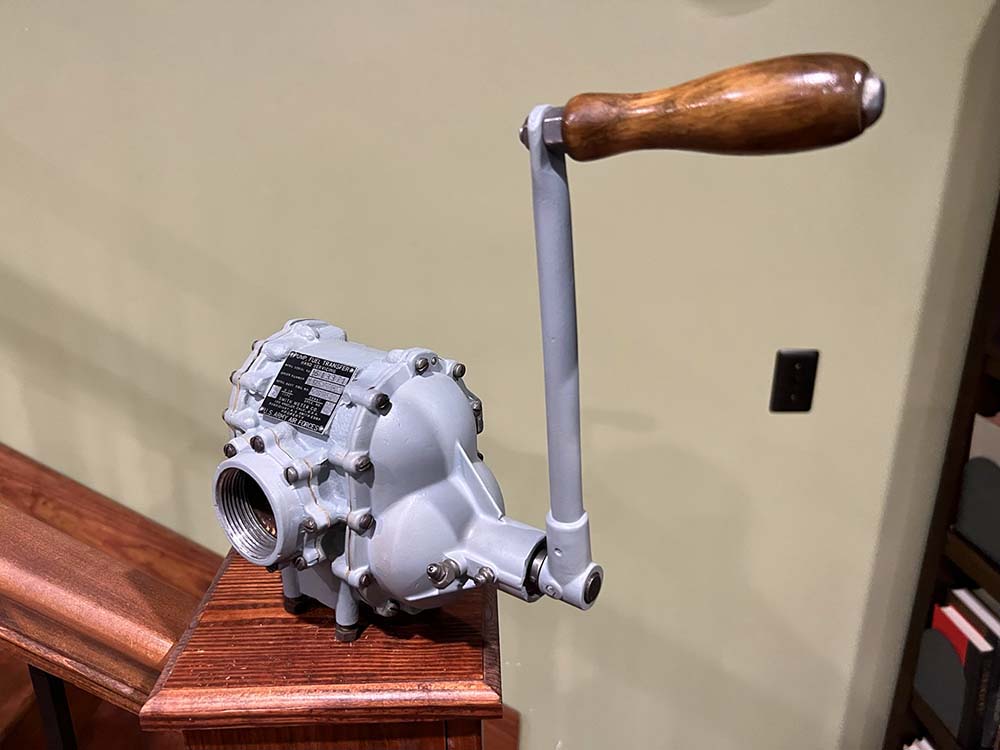
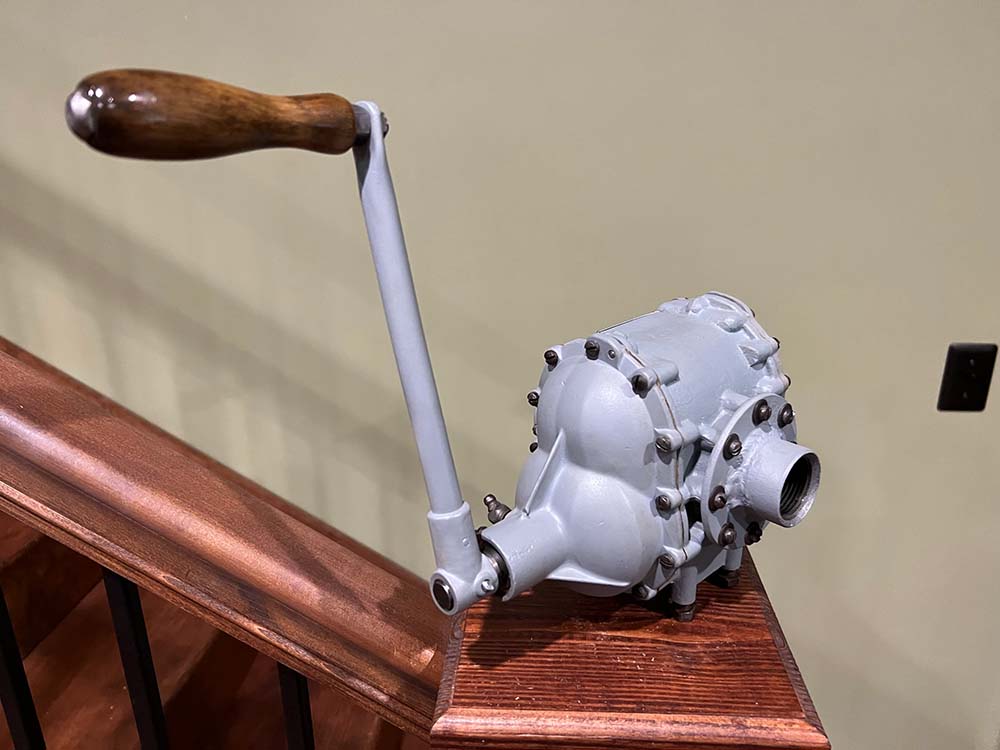
The newly restored Type D-16 Fuel Transfer Hand Pump.
Photo taken 30 August 2022.

Illustration of the Type D-16 Fuel Transfer Hand Pump taken from the Army Index.

The Type D-16 Fuel Transfer Hand Pump aboard an F-model B-17.
The pump was mounted to the lower side of Station 5 (the back wall of the bomb bay), underneath an oxygen panel and walkaround bottle stowage rack.
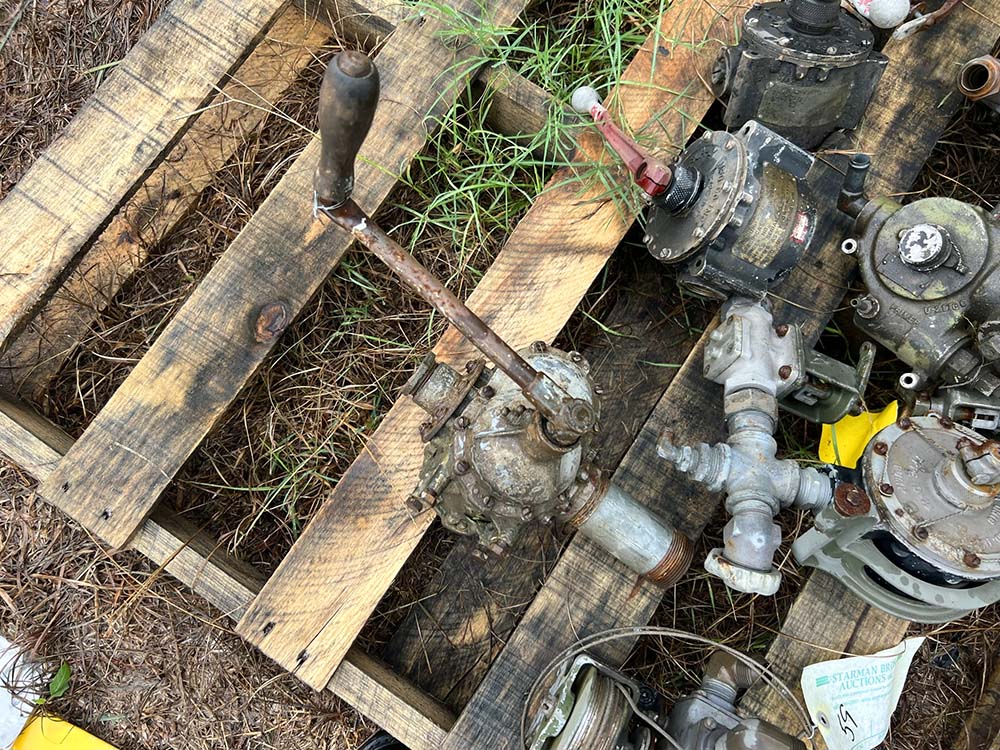
The Type D-16 Fuel Transfer Hand Pump as found at the Wilson Shealy Estate Auction.
Photo taken 12 August 2022.
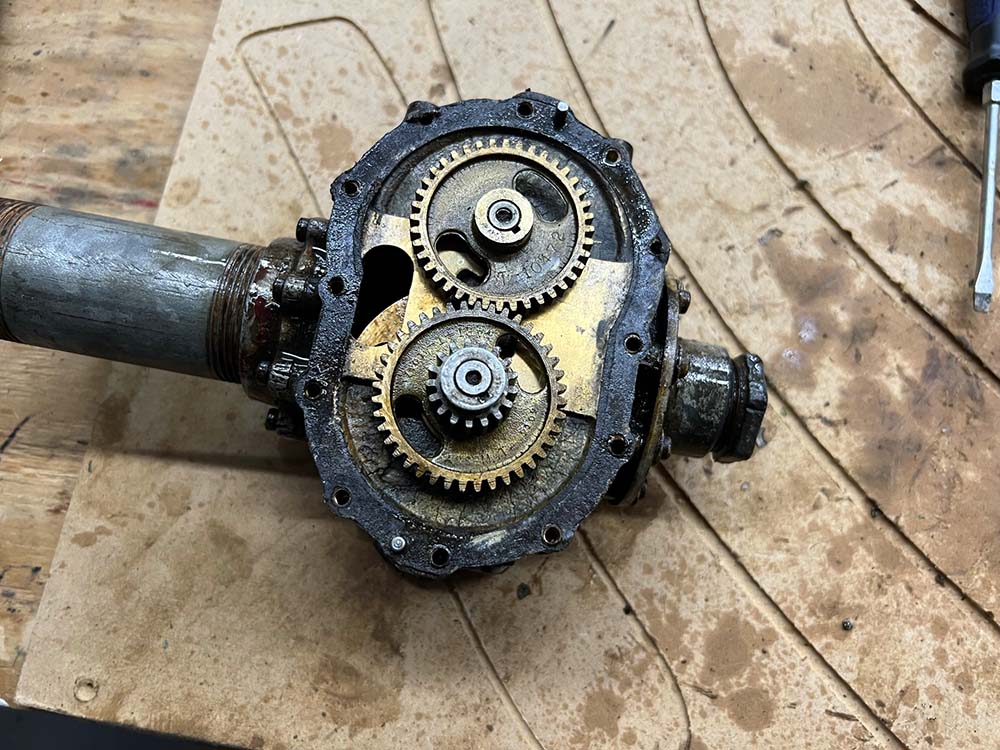
The forward fitting is removed from the Type D-16 Fuel Transfer Hand Pump.
These gears connect the pump assembly to the handle.
Photo taken 23 August 2022.
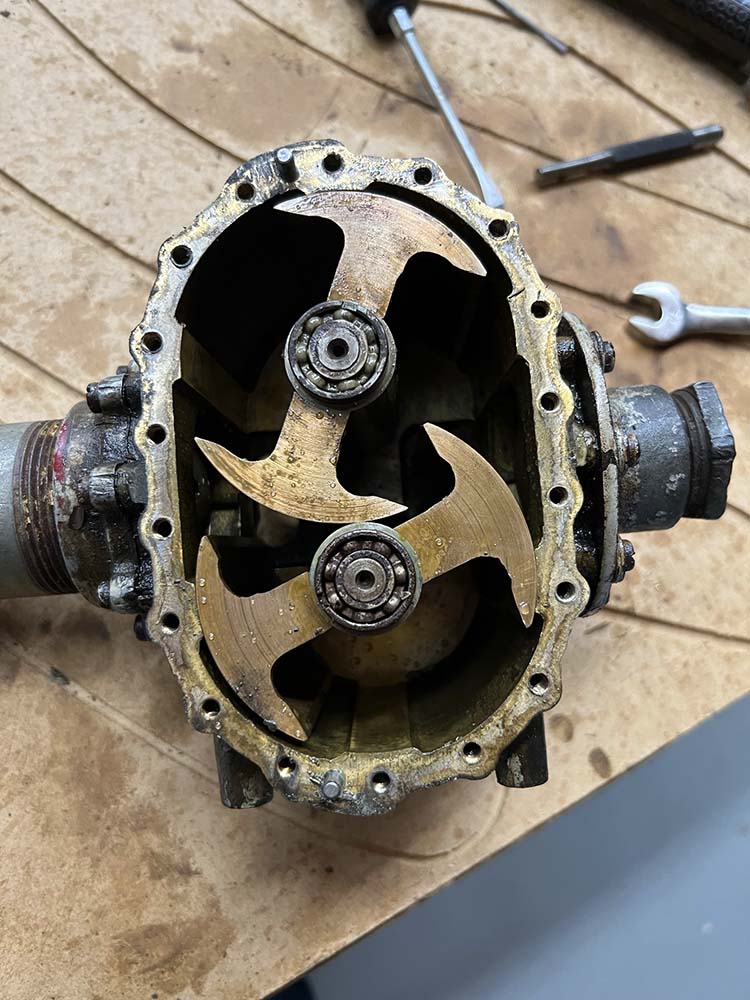
The rear fitting is removed from the Type D-16 Fuel Transfer Hand Pump. The original gasket was missing from this side. A new one was created and installed after cleaning was complete.
Depending on which way the handle is turned, this device can pump in either direction.
Photo taken 23 August 2022.
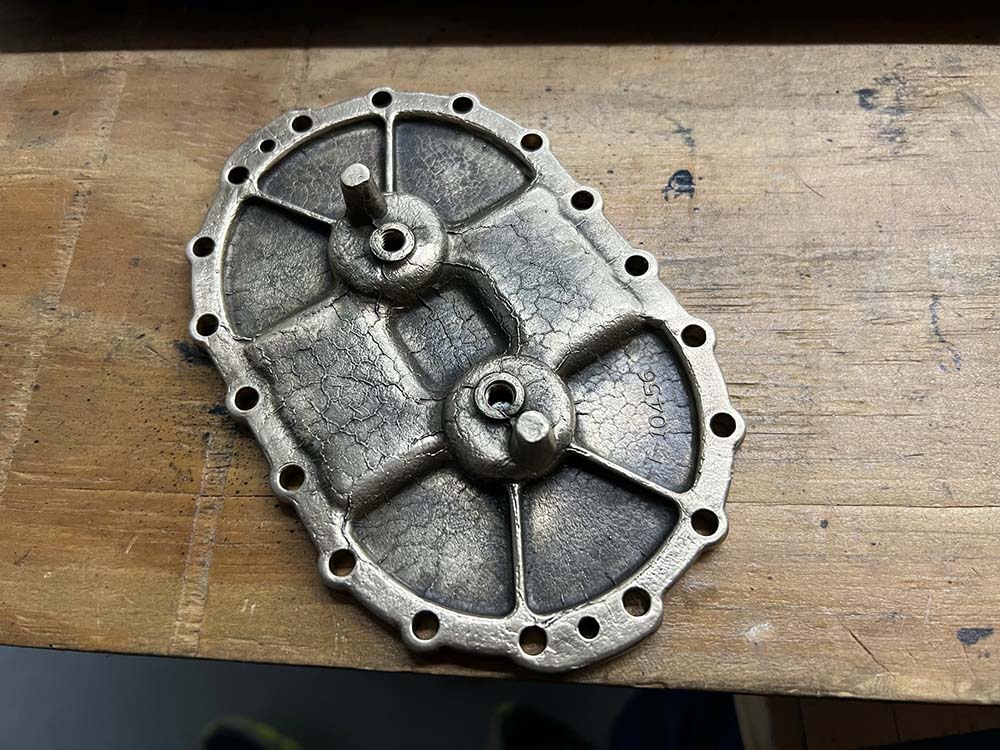
The rear fitting from the Type D-16 Fuel Transfer Hand Pump after cleaning.
Note the wrinkles in the brass – the result of the mold being used far after it needed replacing. These wrinkles were left untouched. This same issue could be seen on the main body of the pump as well.
Photo taken 23 August 2022.
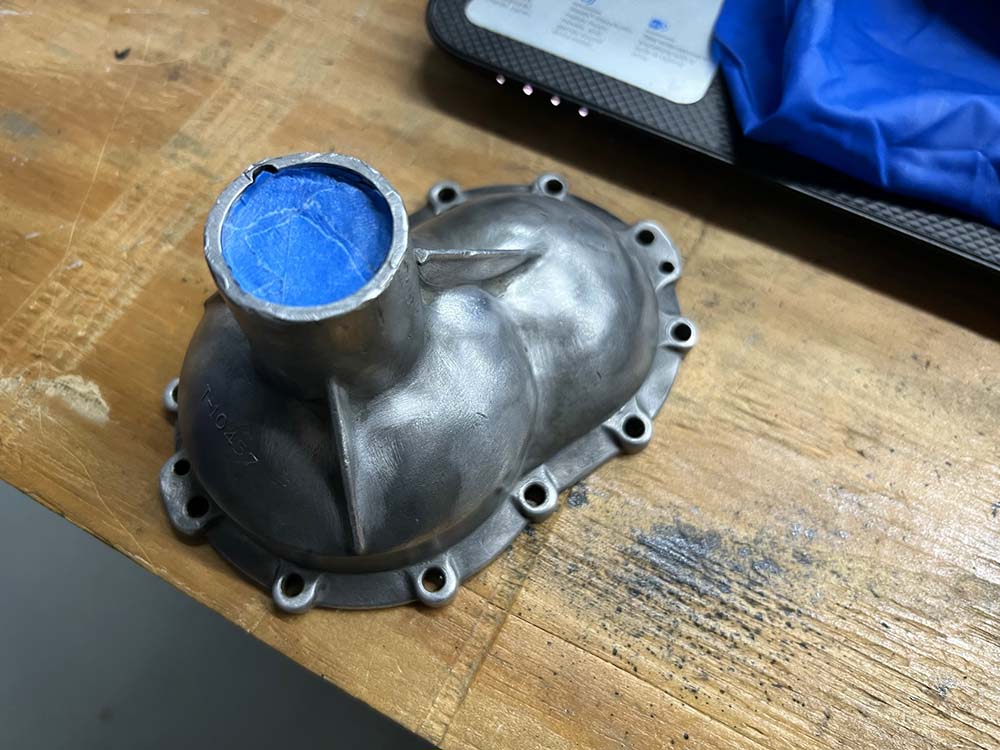
The forward fitting is cleaned and ready for painting.
Photo taken 23 August 2022.

Individual components after being cleaned and repainted.
The pipe fittings on the pump were cleaned and kept, though they were not applicable to the B-17.
While these pieces were carefully sprayed the correct color, the main body was too complex to be sprayed and had to be hand painted.
Photo taken 23 August 2022.
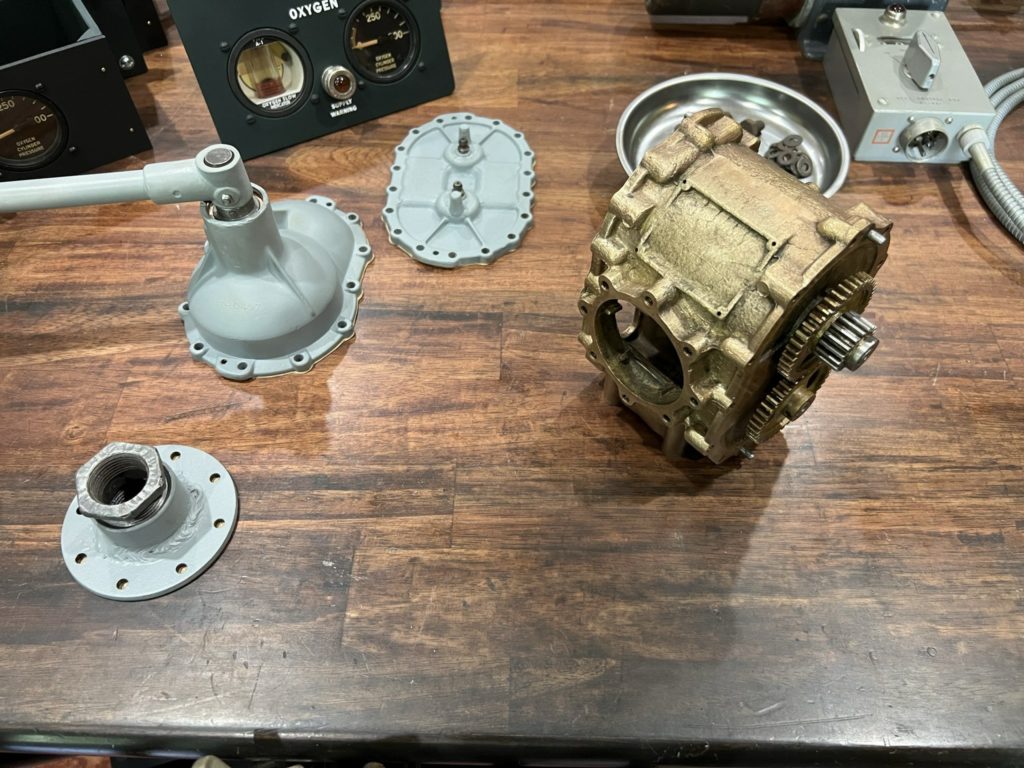
The body assembly is ready for painting after several days of carefully cleaning it with Q-tips to reach into all the fine crevices.
As you can see, just like the back piece, the brass is heavily wrinkled due to its original poor casting. These wrinkles were left untouched.
Photo taken 29 August 2022.

A crude illustration of where the Type D-16 Fuel Transfer Hand Pump will be installed on Station 5 of Lucky Thirteen
Photo taken 31 August 2022.
It’s here!
Back in June we posted a notice that Hangar Thirteen was offered a Boeing B-17 bomb hoist frame all the way down in Australia. Since we have been working on Station 5 of Lucky Thirteen – the very bulkhead on which the bomb hoist frame was stowed – this was too good an opportunity to pass up. However, shipping from that part of the world is never easy, and we turned to our awesome supporters for help.
At first, we tried to auction off an original cowl flap control panel and a piece of artwork made from resin and black walnut. When these failed to arouse interest, our friend Don Price did something amazing – he offered to match up to 500 USD in donations on behalf of this hoist frame. We called it the “Make Don Cry Drive” and you guys delivered! We at Hangar Thirteen wish to give a special thanks to the following as, without you, this piece would not be here today:
Stijn Claus
Nicolas Godfurnon
Chris Hrabina
George Hunt
Robert McHugh
Rian Olsen
SSgt Max Pearsall, USAF
Don Price
George Thurston
To briefly recap, the bomb hoist frame was a cast aluminum piece which came standard on every B-17. Stowed on Station 5 (the back wall of the bomb bay), the frame held a pair of hand-cranked winches. When loading ordnance, this frame was clipped above one of the racks and the cables lowered. The cables would then be clipped to a bomb and cranked back up into the bay, repeating the process for each bomb as needed. In 2019, an unissued set of wartime winches was located and acquired, and in June of 2022, Station 5 of Lucky Thirteen was fully skinned. We were ready.
During the fundraiser we were contacted by Gerald Corfield in Dunedin, New Zealand, offering to donate a ball turret azimuth gear to the project. We were blown away! This gear connected to one of the hydraulic transmissions on the turret’s ‘double power unit,’ connecting the assembly to the ball’s trunnion gear as to rotate the ball. Gerald’s gear box was green which, along with its serial number, indicated that it was manufactured by Emerson Electric in St. Louis, Missouri. Rather than ship it direct, Gerald sent the gearbox to Australia, where it was packed alongside the bomb hoist frame. This ball turret azimuth drive is in remarkable shape as, even only using fingers, the gears turn smoothly. A very special thanks to Gerald for this amazing piece!
This was certainly a tough one and we cannot stress enough how thankful we are for our supporters. We know how tiring it is to be constantly asked for donations. But without you, we would not be able to accomplish such amazing things. There are no millionaires here – just a team of hard-working people with a passion for history. And projects like this are rarely affordable. For example, when we decided to try and acquire these pieces, we decided to use DHL for shipping since its online calculator quoted 662.12 USD. The actual total came to 1,122.27 USD.
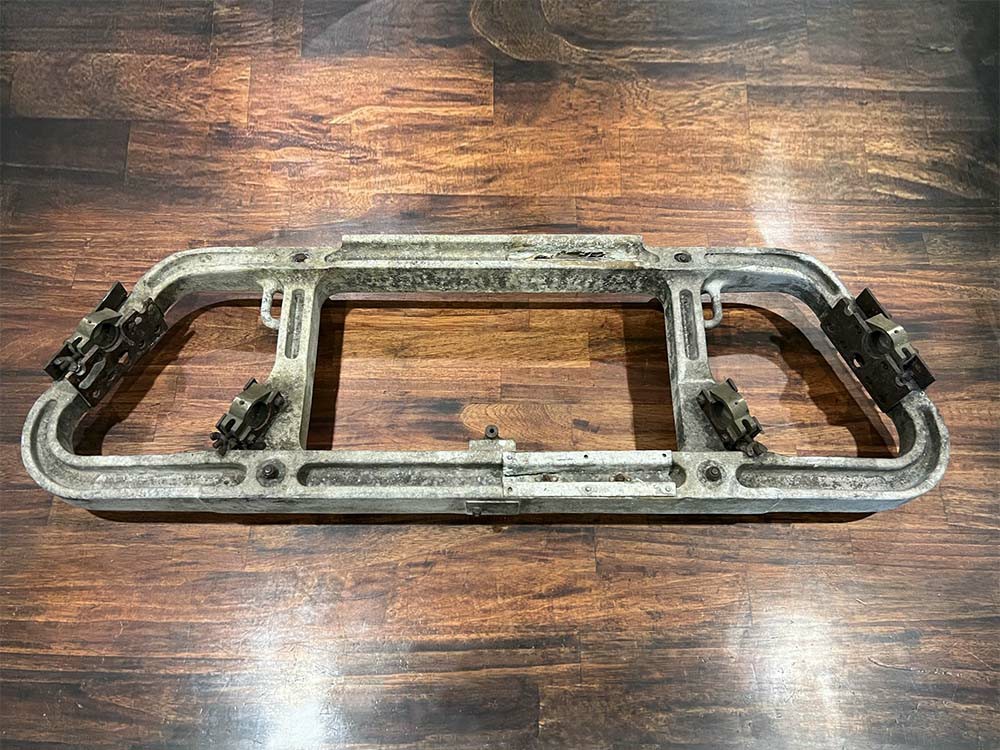
The newly arrived bomb hoist frame sits on my dining table.
The clamp assemblies hold the two winches, which we acquired in 2019.
Photo taken 29 August 2022.
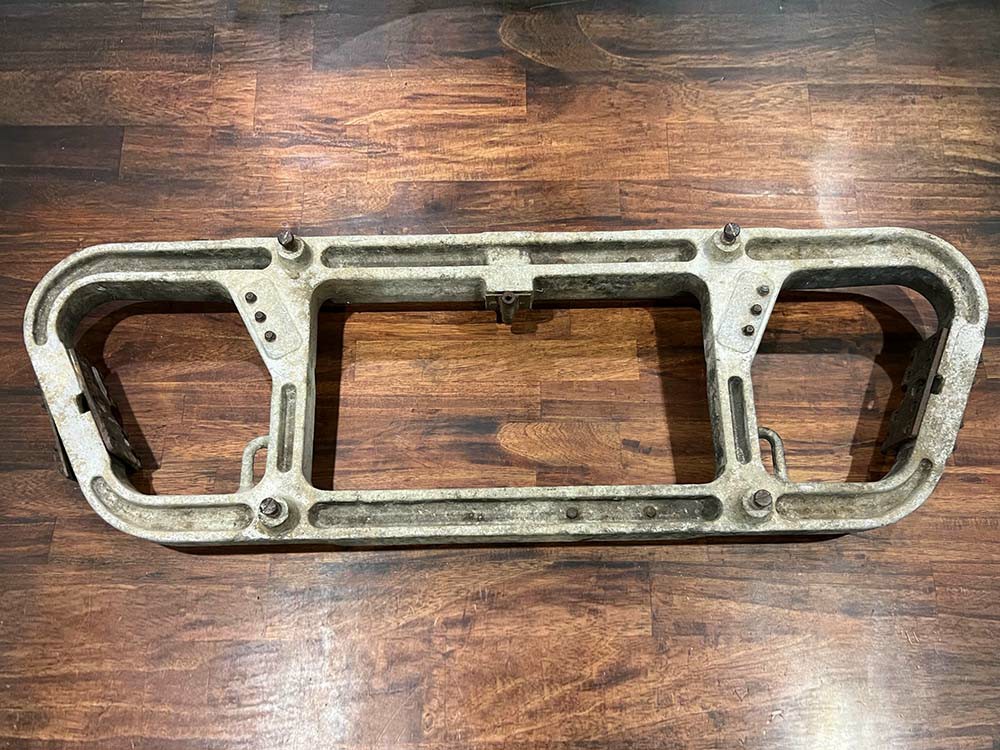
The newly arrived bomb hoist frame sits on my dining table.
The studs on this side are what clips the assembly to Station 5 for stowage.
Photo taken 29 August 2022.
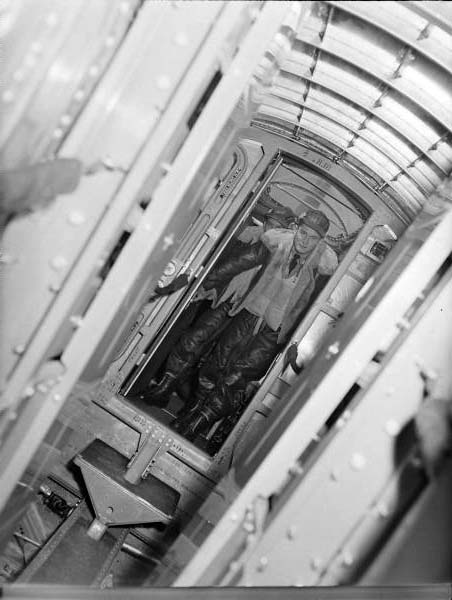
A LIFE magazine photo showing the bomb bay of a B-17 at MacDill Army Airfield.
The bomb hoist frame can be seen in the bay, to the left of the door – this is its stowage location on Station 5.
This image, when originally published, was mirrored. It has been corrected here.
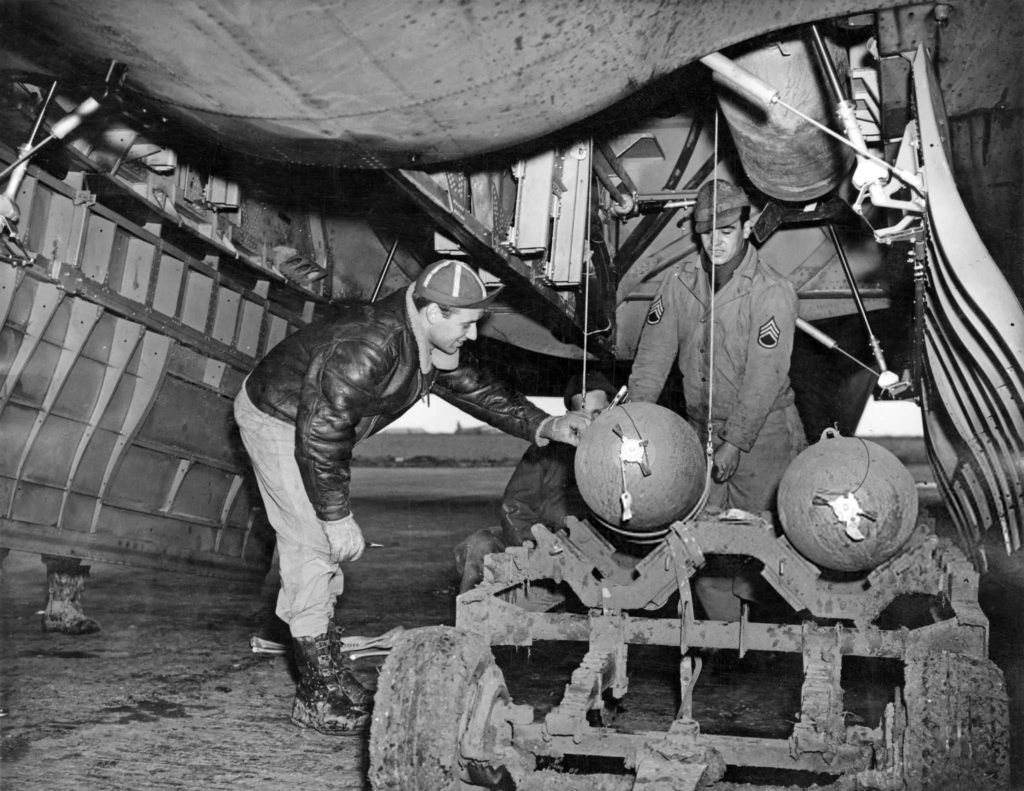
US 8AF ground crews load ordnance, cranking the winches down to hoist up one bomb at a time.
While this photo is dated 18 December 1942, no operations were launched this day. More likely, the crews are loading for the strike of 20 December 1942.
Note the mud. Mud was such an issue in East Anglia that many airbases had markers warning aircraft not to veer off the asphalt because of the terrain.


Gerald Corfield’s newly donated ball turret azimuth gear.
While the ball turret was designed by Sperry Gyroscope, Sperry did not have the capability to manufacture them in house. This piece was made by Emerson Electric in St. Louis, Missouri. The part number, 205188, can be seen on the left.
Photo taken 29 August 2022.
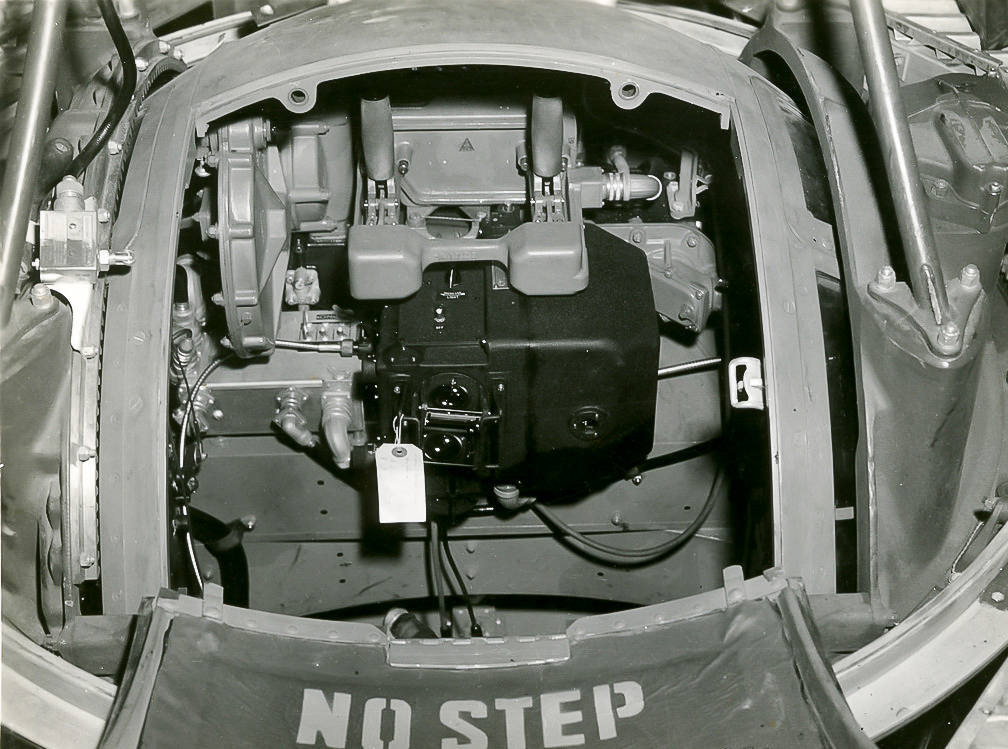
A Type A-2 Ball Turret built by Briggs Manufacturing of Detroit, Michigan. Briggs built turrets were generally painted gray inside.
The ball turret azimuth gear can be seen to the right of the gunsight.

A Type A-2 Ball Turret built by Emerson Electric of St. Louis, Missouri. Emerson built turrets were generally painted dark green inside.
Emerson Electric was originally assigned to build turrets for the Consolidated B-24, however due to the massive expansion of their factory, Emerson also supplemented B-17 turret producers Briggs and SPECO.
Briggs was not an amiable partner and, because of poor business relations, Emerson made far fewer ball turrets than Briggs.

The newly-arrived crate from Australia sits in the back of our F-350.
Note the Hangar Thirteen car vinyl in the window. You can find these in our online store!
Photo taken 29 August 2022.
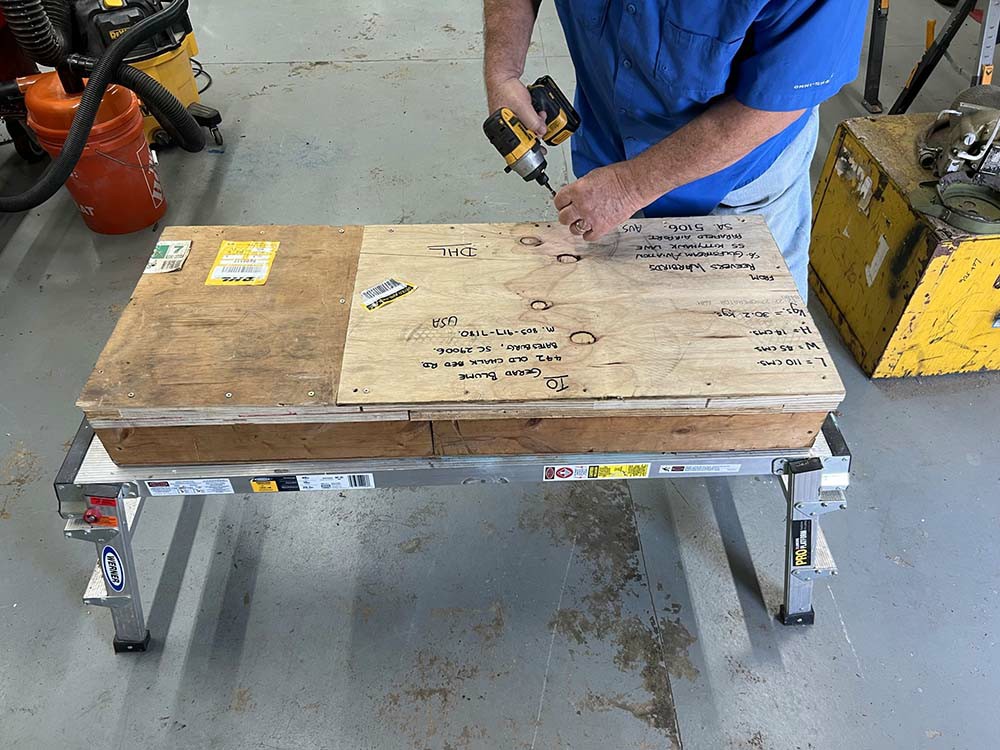
Opening the crate in our woodshop.
My family’s woodshop is far less tidy than the hangar…
Photo taken 29 August 2022.
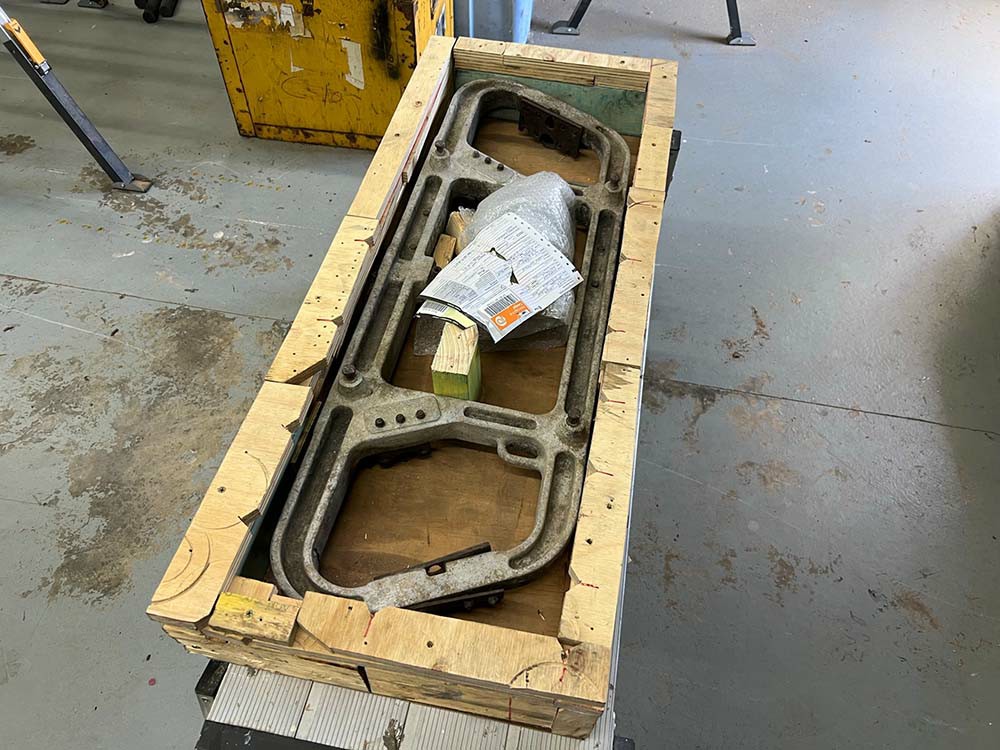
Our friends in Australia did a fantastic job packing these parts. Thanks guys!
Photo taken 29 August 2022.
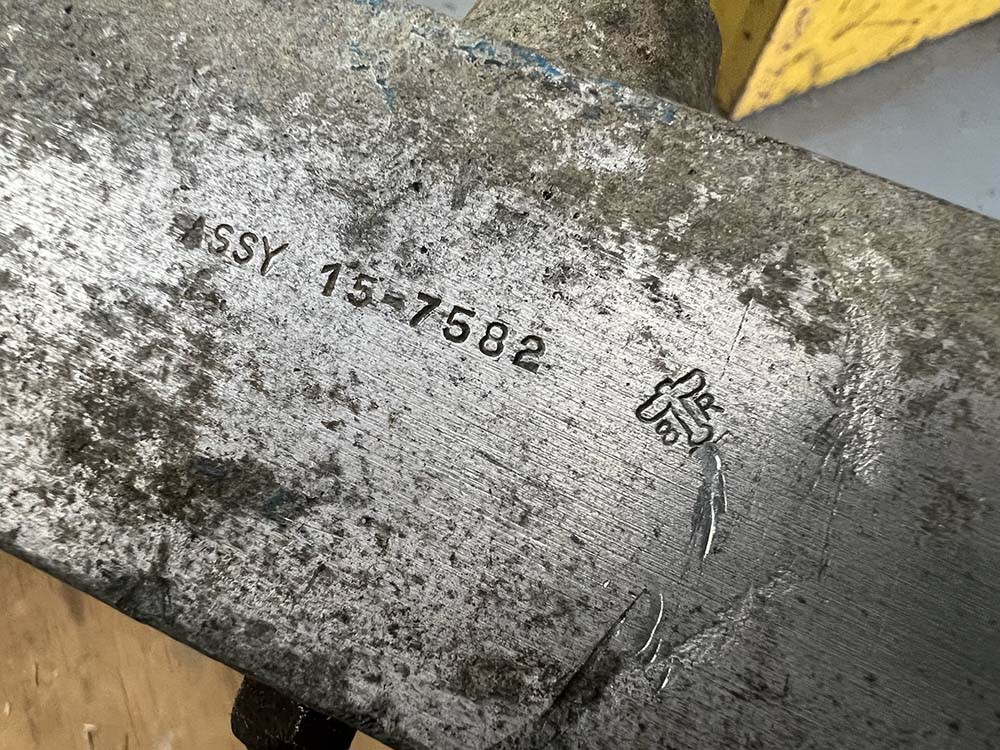
A fun little detail – the Boeing totem logo is stamped alongside the hoist frame’s part number.
Photo taken 29 August 2022.
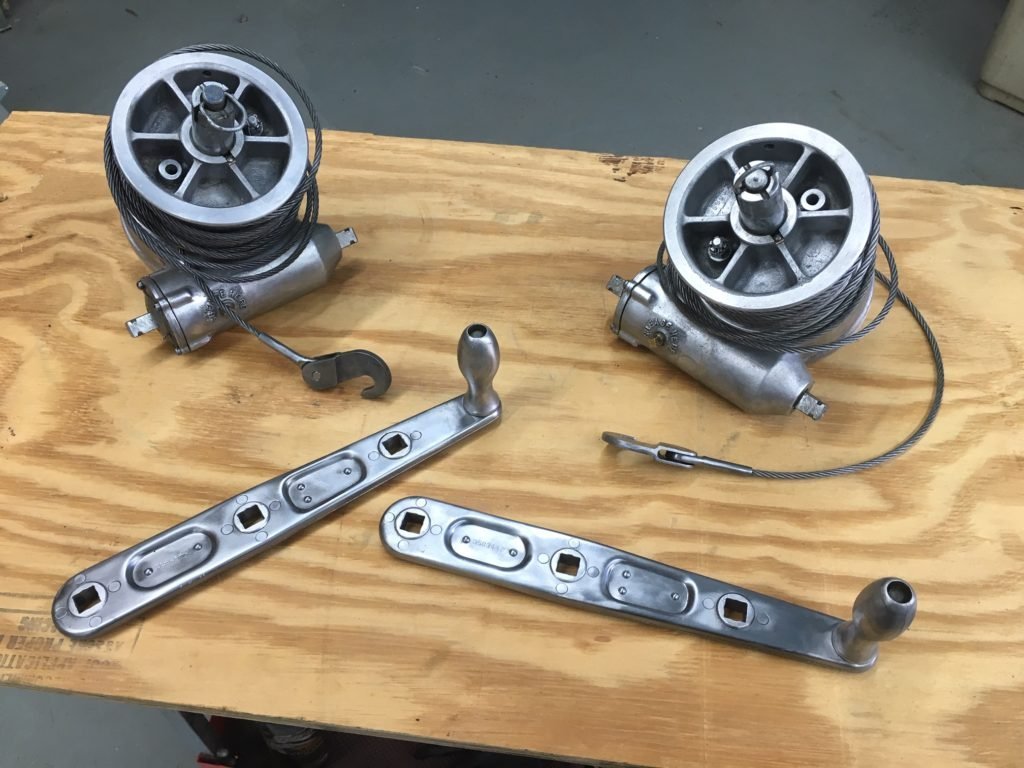
Hangar Thirteen’s NOS Bomb Hoist Winches after being cleaned of 80 years of cosmoline.
Photo taken 4 January 2019.
Our friend Eric Miller of Project Warbird has recently acquired a Vultee BT-13 Valiant at a nearby estate auction, and we had a blast helping him disassemble the old bird and take it back to his shop.
Not all of us at Hangar Thirteen live near the hangar in Asheville, North Carolina. In fact, most of us work from home, communicating online to work together for the B-17F’s needs. For my part, my hometown is Batesburg, South Carolina – some three hours away from Asheville (and even then, I live outside of town). The Shealy family is prominent in my area, being particularly renown for the Shealy barbeque restaurant downtown. Wilson Shealy was known to me by reputation. My father’s side of the family were largely carpenters, and my uncles frequently told me stories of the time they worked at Wilson Shealy’s place. One favorite was the old man telling them that he was going to do a fly-by while they worked, later doing just that, waving as the biplane came by upside down!
Shealy was supposedly hounded by treasure hunters throughout his life, which is why he lived so secluded. His passing resulted in an unusually large number of people descending on my little town. There were more ex-cropduster Stearmans than one could imagine, and so many PT-19 fuselage frames that they couldn’t sell them all. The BT-13 was the oddball of the collection. Supposedly, Shealy had only purchased the trainer because he wanted the engine, setting the rest of the airframe aside these last 70 years. A true time capsule.
I had never been to an auction before, and I would have been completely lost without Eric’s help! It took three days to get though everything. During that time the weather was awful, the hours out in heavy rain being easier than the extreme humidity we got when it paused. Naturally, we did not win everything that could be applied to Lucky Thirteen. The big losses were a Type A-2 Carbon Tet extinguisher still with its bracket, a box of six Bendix Pioneer Type A-12 Oxygen Regulators, and a box of Army issue seatbelts (both used and NOS).
Still, we did make some headway.

Floppy hat – essential for preventing sunburn on the neck!
Helping Eric disassemble the BT-13.
Photo taken 20 August 2022.

The Type G-1 Oxygen Tank acquired at the Wilson Shealy estate auction.
The Boeing B-17 carried eighteen of these tanks. We need six more to have a complete set for Lucky Thirteen.
Photo taken 21 August 2022.

A manual illustration showing the crawlway under the cockpit floor of a Boeing B-17.
Several of the bomber’s oxygen tanks were mounted here.
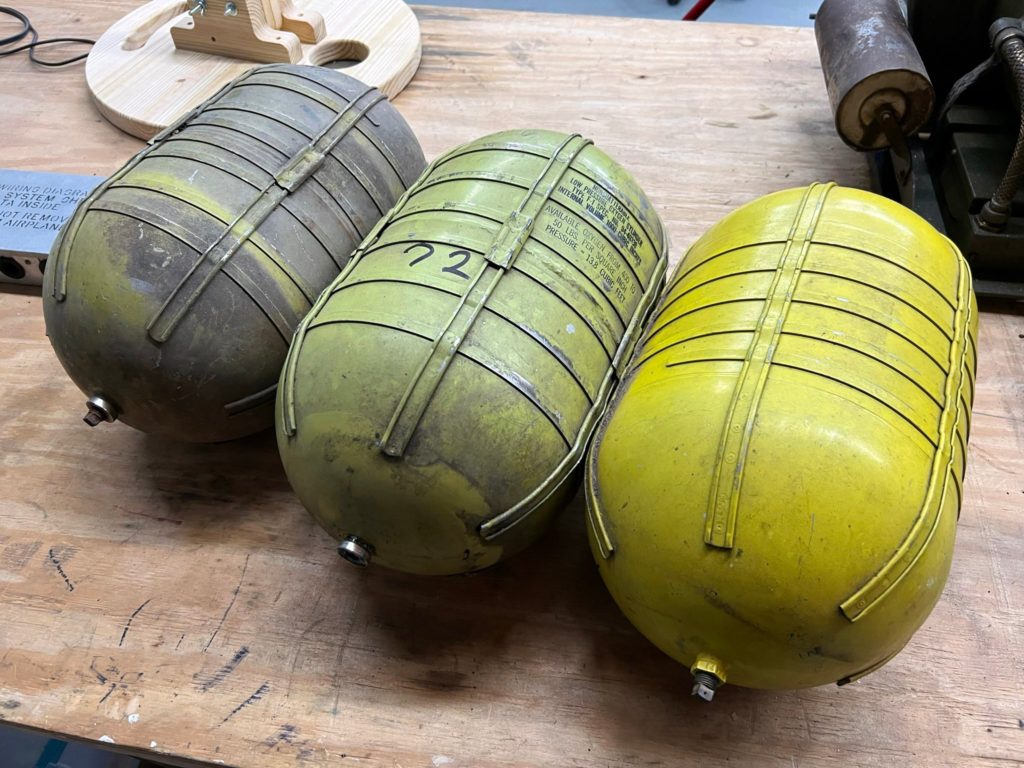
The three Type F-1 Oxygen Tanks acquired at the Wilson Shealy estate auction. These tanks complete our F-1 tank needs for Lucky Thirteen.
The F-1 was a smaller version of the G-1, being designed for use with powered gun turrets.
We originally acquired four, but the fourth was donated to the South Carolina Historic Aviation Foundation.
Photo taken 21 August 2022.

A Type A-2 Ball Turret equipped with a Type F-1 Oxygen Tank.
The ball turret for Lucky Thirteen was identical to what you see here.
Note the nacelle ladder stowed away on the right wall. These were usually kept by the ground crews.
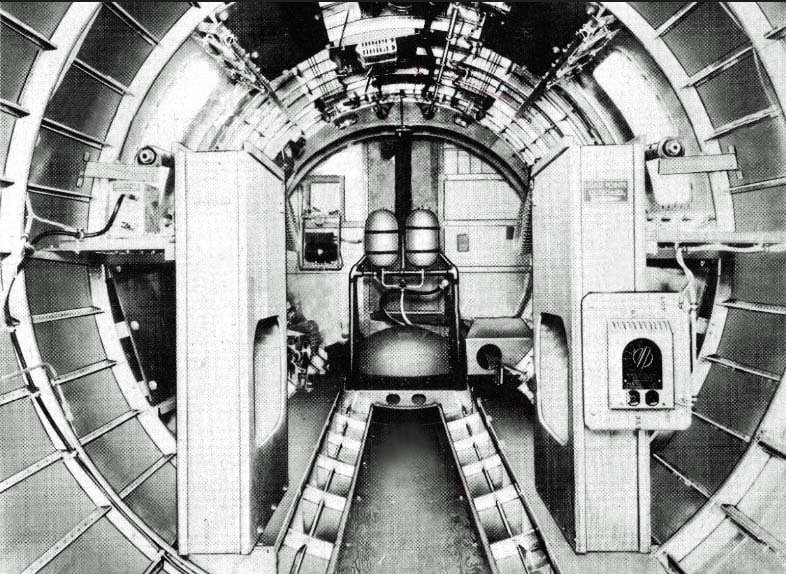
Unlike the top turret, it took some time to develop a way to connect the ball turret to the aircraft’s primary oxygen system.
The F-1 Oxygen Tank needed regular recharging and in the summer of 1943, many B-17Fs were altered to mount multiple Type F-1 tanks to their ball turrets.
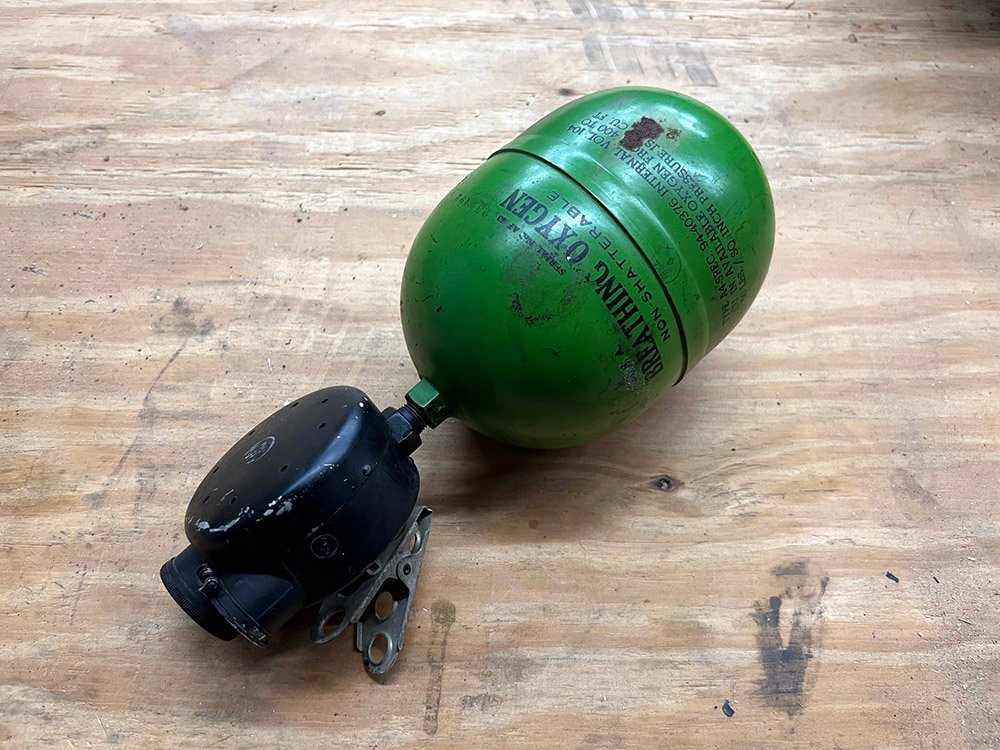
The Type A-4 Walkaround Oxygen Bottle acquired at the Wilson Shealy estate auction.
Lucky Thirteen needs an additional eleven walkaround bottles to have a full complement.
Photo taken 21 August 2022.

An unidentified airman squeezes through the bomb bay of a B-17, carrying a Type A-4 walkaround oxygen bottle.
The first of the demand-flow walkaround bottles, the A-4 gave the airman between 3 to 8 minutes of breathable oxygen.

The single wartime seatbelt acquired at the Wilson Shealy estate auction.
Seatbelt Types B-11 through B-15 were almost identical in appearance.
Lucky Thirteen was equipped with six B-11/B-13/B-15 seatbelts, three A-3 gunner’s belts, and two A-4 turret safety belts. So far, we have three seatbelts and one gunner’s belt.
Photo taken 21 August 2022.
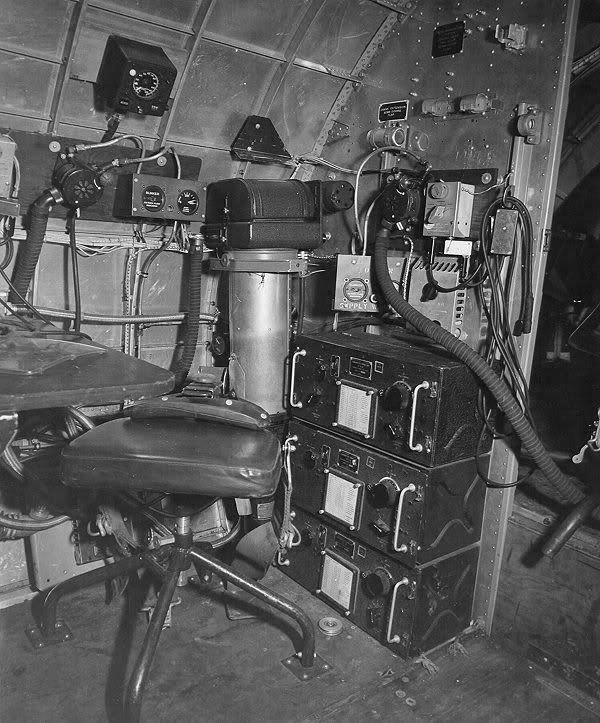
A photo taken aboard a B-17G Pathfinder toward the end of the war.
The Cramer posture chair, here installed for the radar operator, has been taken from an old bombardier’s position. The folding backrest is so the airman can waddle off the chair with ease.
Note the seatbelts dangling off the sides of the chair.

The Bendix Pioneer Type A-12 Oxygen Regulator acquired at the Wilson Shealy estate auction.
Multiple companies produced regulators for the Army Air Forces during the war. We intend to outfit Lucky Thirteen with the Bendix Pioneer type, which is distinguishable by its rounded edges.
The B-17 carried fifteen A-12 regulators. So far we have acquired seven.
Photo taken 21 August 2022.

My wife Megan poses with the newly-acquired Type A-12 regulator, now mounted to the radio operator’s oxygen panel.
Photo taken 21 August 2022.
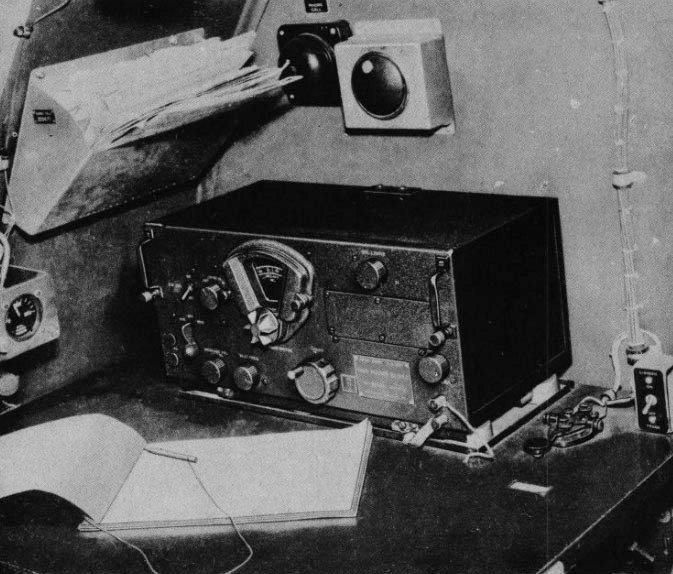
The radio operator’s oxygen panel is visible to the left of his desk in this manual photo.
Note the ashtray and bailout alarm bell mounted above the liaison receiver radio.
The radio operator position on Lucky Thirteen was very similar to this, though her master switch was inlayed into the desk rather than mounted to the wall.
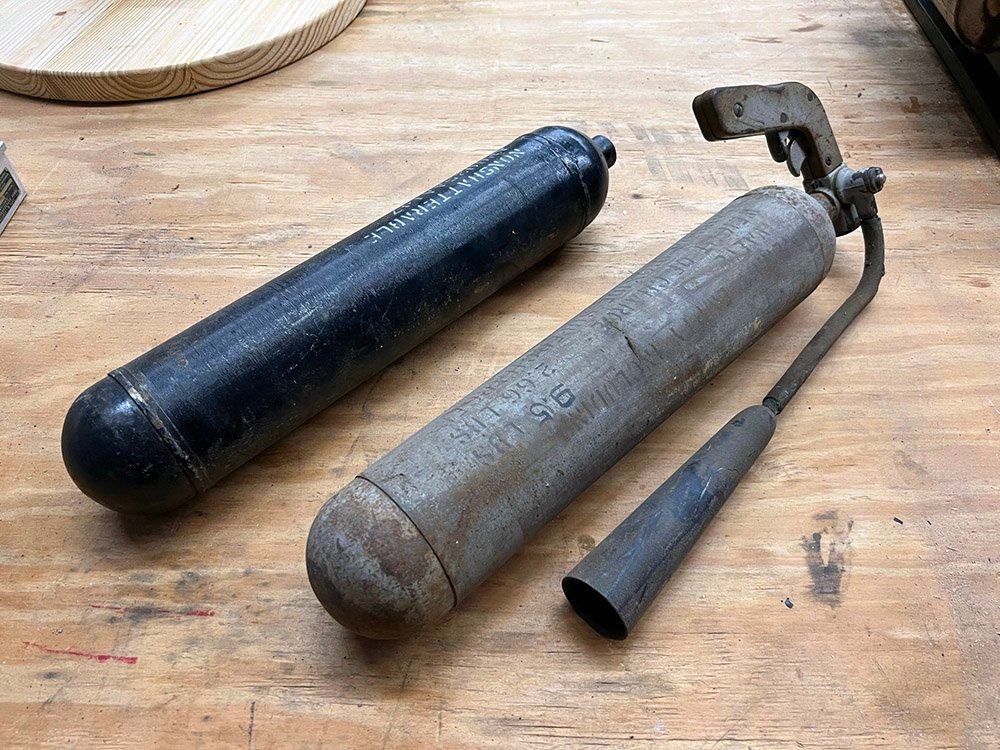
The 4TB Fire Extinguisher and spare extinguisher cylinder acquired at the Wilson Shealy estate auction.
Photo taken 21 August 2022.

Our progress toward CO2 extinguishers prior to the Wilson Shealy estate auction.
The B-17 carried either three CO2 extinguishers, using either the 4TB or the Type A-17. The two on the right are Type A-17s.
We have yet to complete a matched set. The one on the right is untouched since the war. The one in the middle has been restored but is missing its wire-mesh wrap. The one of the left is a 4TB missing its handle assembly.
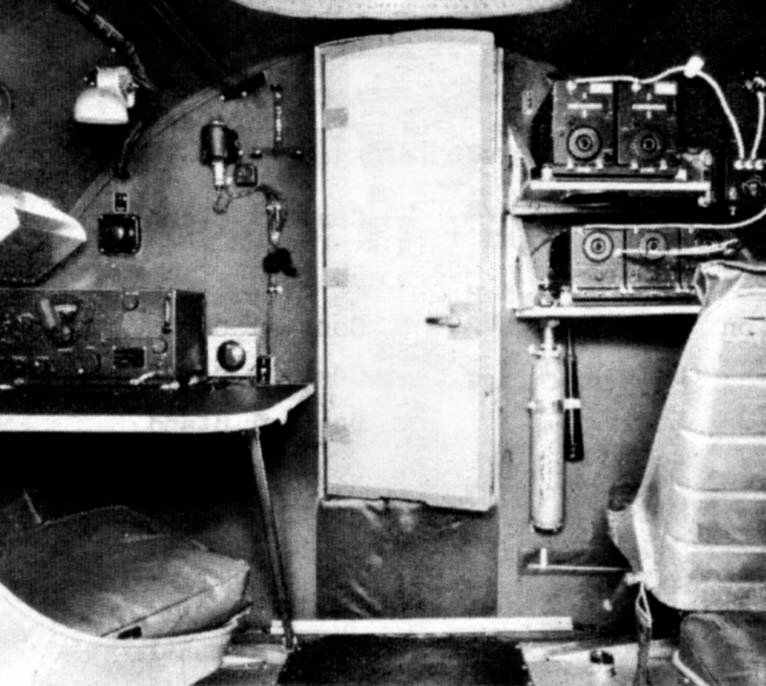
Station 5, the front wall of the radio compartment, facing forward. Note the Type A-17 fire extinguisher mounted here.
The 4TB acquired at the auction is a helpful backup to our project, but we are hoping to manage a matching set of three A-17s for Lucky Thirteen.
Thanks to the auction, we now have three matching cylinders. If we were to swap the cylinders on our A-17 without the mesh, and someone was to machine the brass fittings to make a third, we could restore a full set of three A-17s.
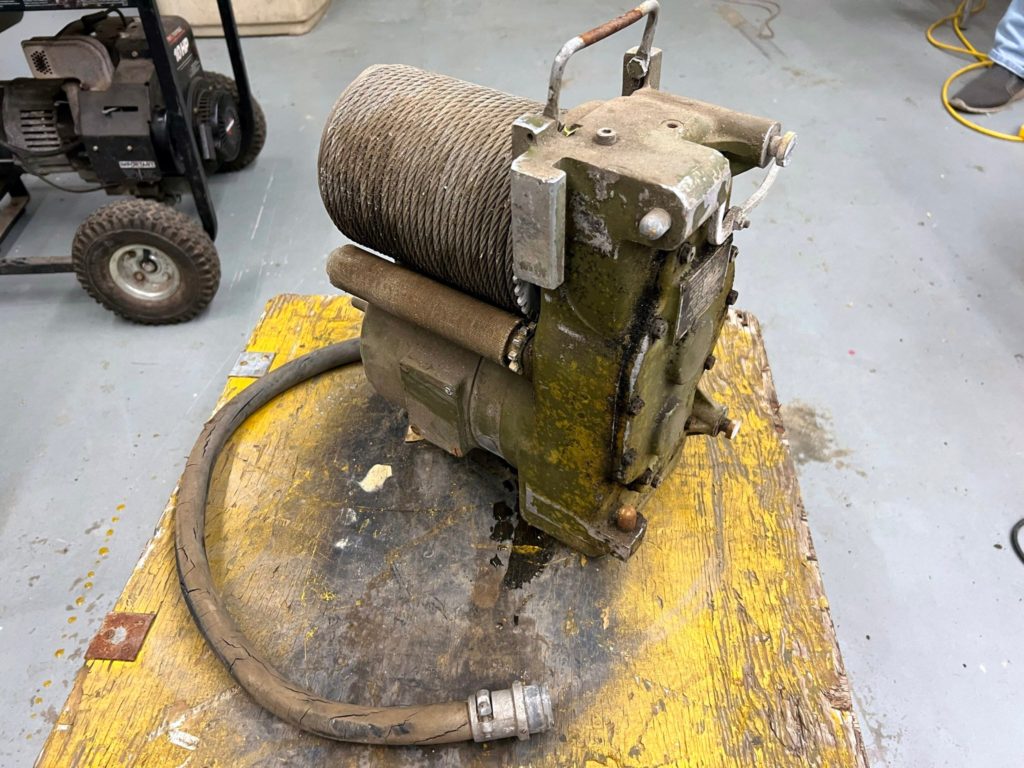
A Type C-10 Electric Bomb Hoist acquired at the Wilson Shealy estate auction. The box it is sitting on contains two more.
These units have not yet been cleaned.
A late-war design, the C-10 was primarily used in the late-1940s/early-1950s on Boeing B-29s, B-50s, and Convair B-36s.
Photo taken 21 August 2022.
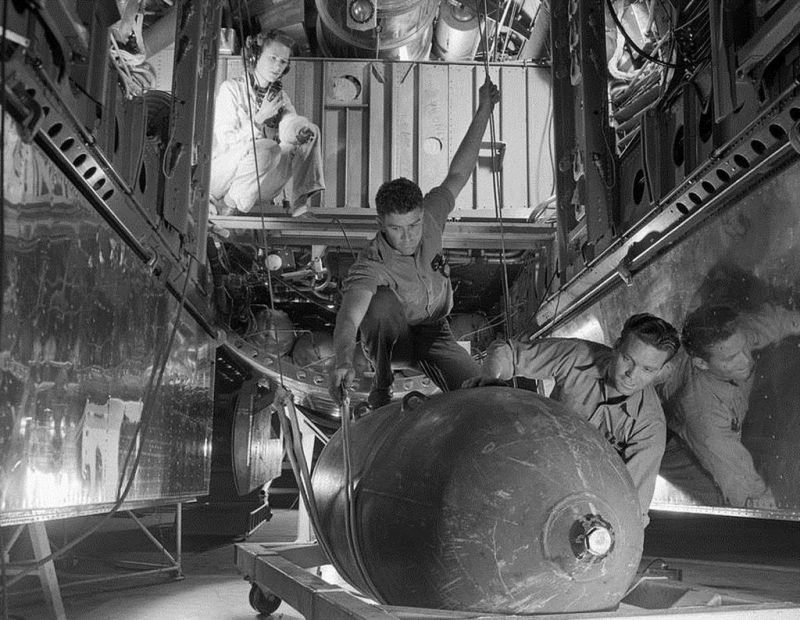
Boeing employees test an electric bomb hoist aboard a B-29 at their Renton, Washington factory.
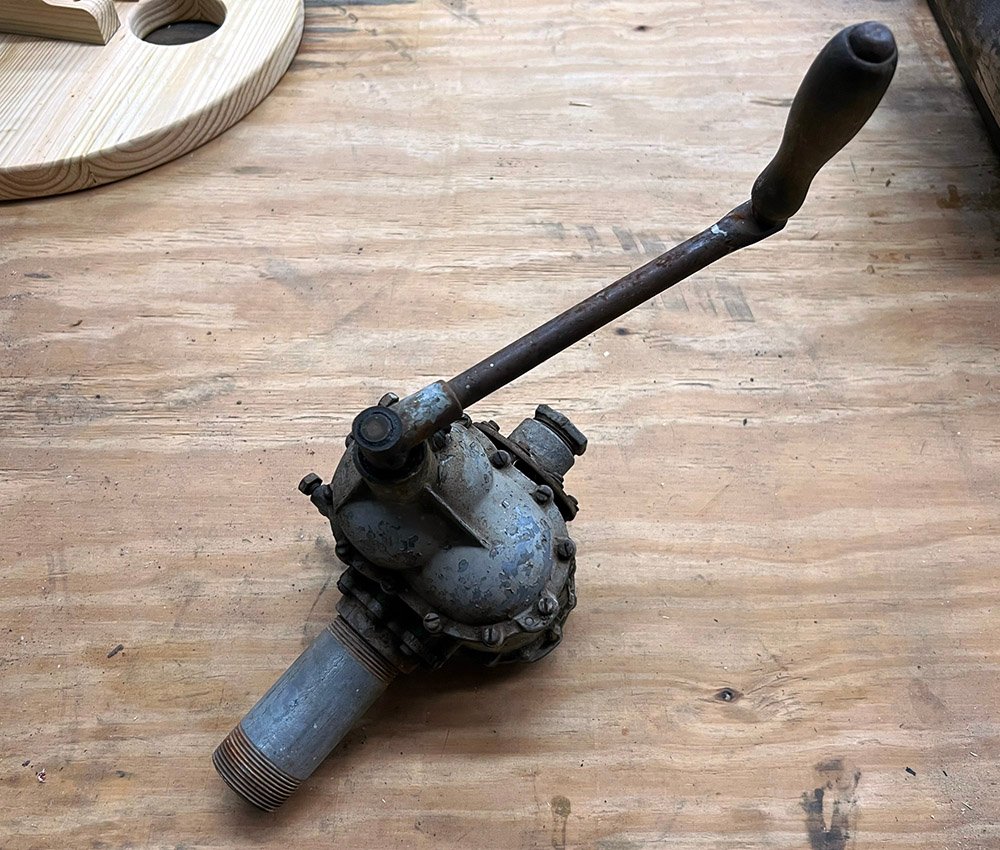
The Type D-16 Fuel Transfer Handpump acquired at the Wilson Shealy estate auction.
A backup for when the electric pumps failed, the pump transferred fuel from one wing of the B-17 to the other. The direction the fuel flowed was determined by which way the crank was turned.
Photo taken 21 August 2022
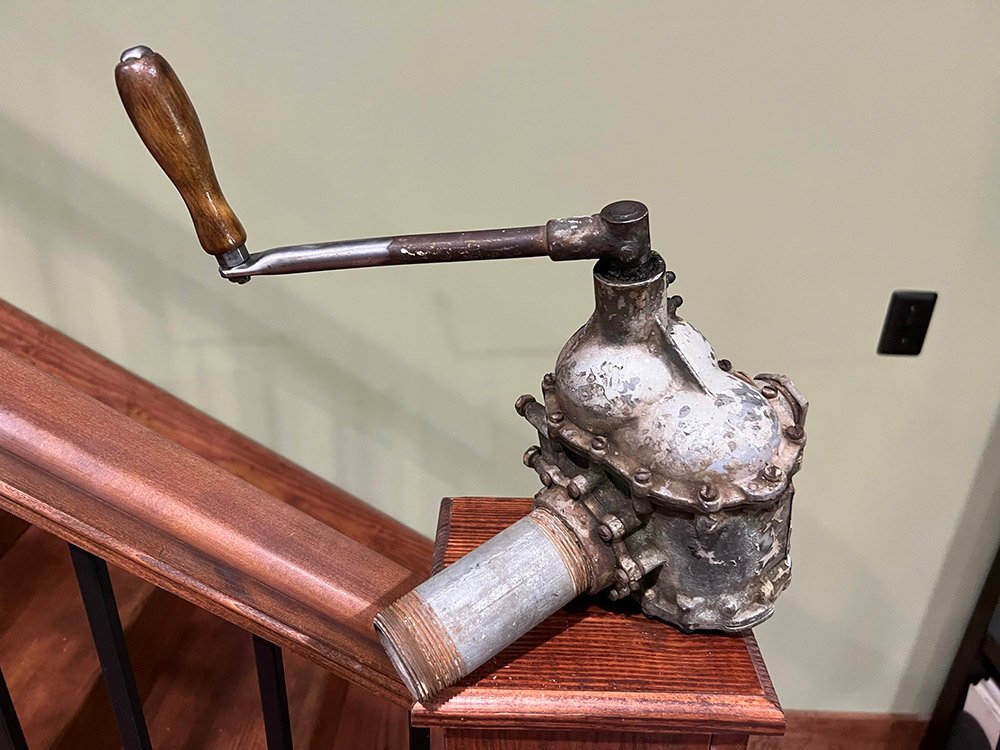
The handle is cleaned – the first step toward restoring the Type D-16 Fuel Transfer Handpump.
Photo taken 21 August 2022.
The framing is now completely riveted and our friend Eric Miller of Project Warbird will be soon coming up to help permanently rivet the skins. We also have a couple new volunteers due to join us in Asheville soon, which will be wonderful – many hands make work light (in theory).
It will not be long before we can begin mounting some of the equipment that goes onto this bulkhead. My personal favorite is the door (for selfish reasons) but a special thanks is especially due to our friend Robert Kropp, as Robert contributed door handles and latches to help us finalize the bomber’s interior doors.
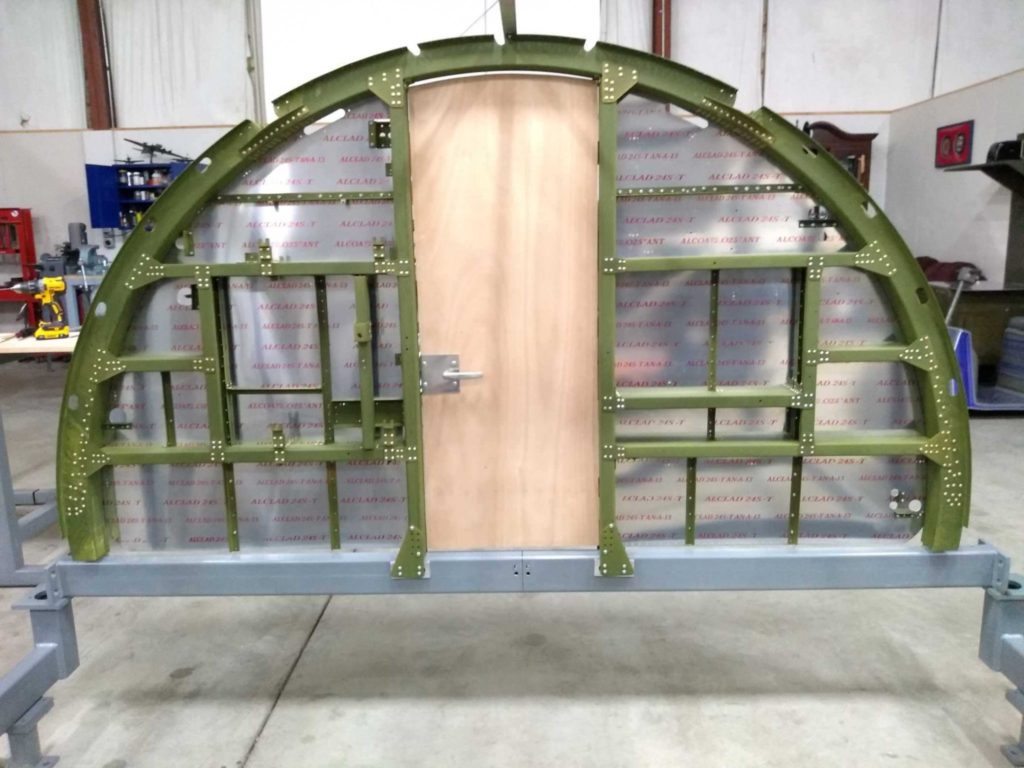
The bomb bay side of Station 5 for Lucky Thirteen.
Note the recreated wartime ALCLAD stamps. Also note the colorization of the zinc chromate. This comes from replicating the original practice of dipping the parts rather than spraying them.
Photo taken 15 August 2022.
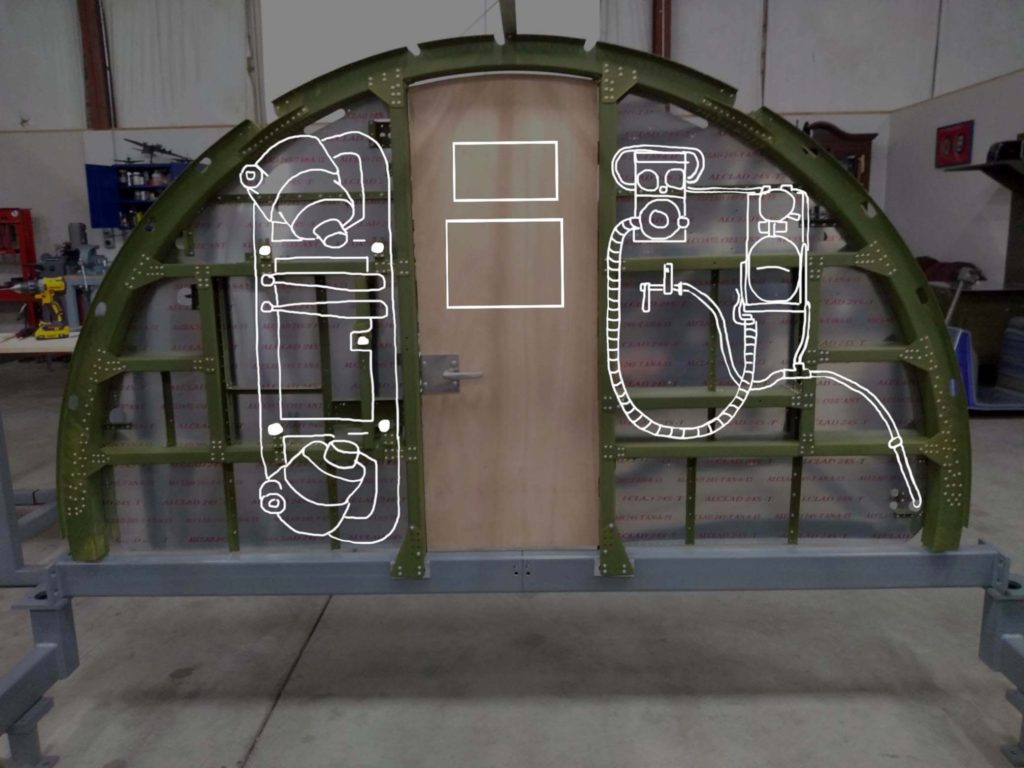
A crude drawing showing the equipment which will soon be mounted here.
To the left is the bomb bay hoist rack assembly. On this piece we may have some news soon…
On the right are components of the bomb bay’s oxygen station. The gauges and regulator are high next to the door. A portable oxygen unit is clipped to the right. The hose to the oxygen hookup is clipped to the portable oxygen bracket when not worn. Similarly, a portable oxygen recharge line is clipped to the bulkhead, the primary oxygen line running through the hole on the bottom corner.
Two charts are glued to the door: the upper chart being a loading diagram, the lower chart a guide to using the bomb bay fuel transfer handpump.
Photo taken 15 August 2022.
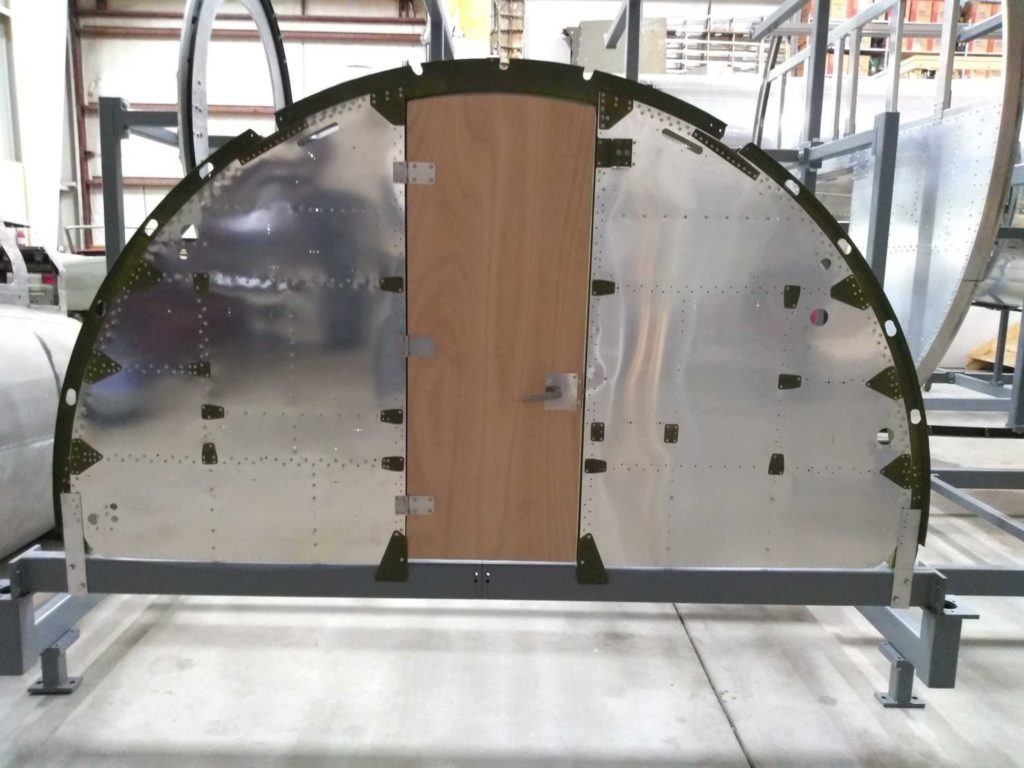
The radio room side of Station 5 for Lucky Thirteen.
The left side will hold the radio operator’s desk, his ashtray, and the IFF control box and inertia destruct switch.
The right side will hold a pair a shelves for the Command Radio transmitters, receivers, and relay.
Photo taken 15 August 2022.
